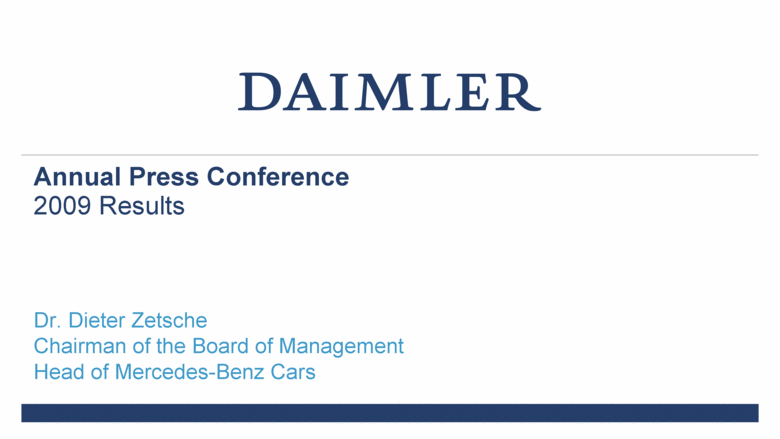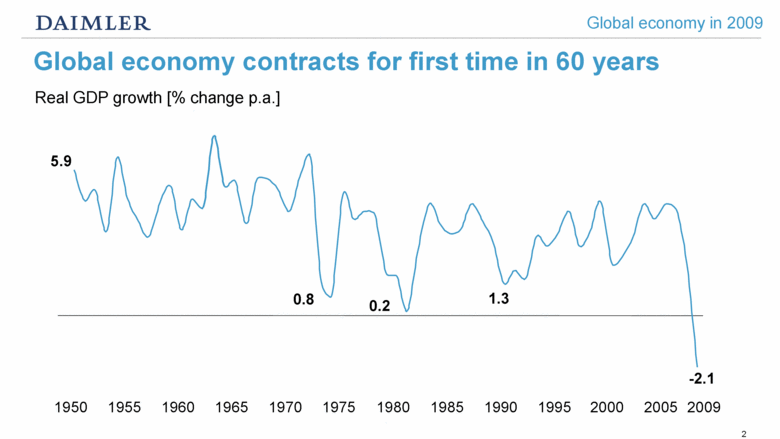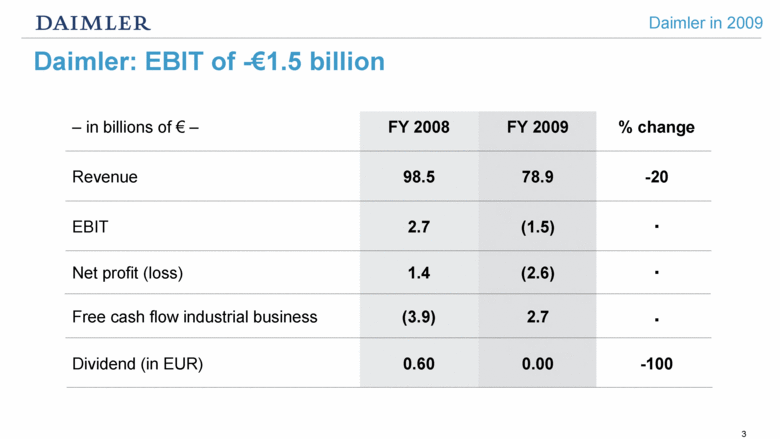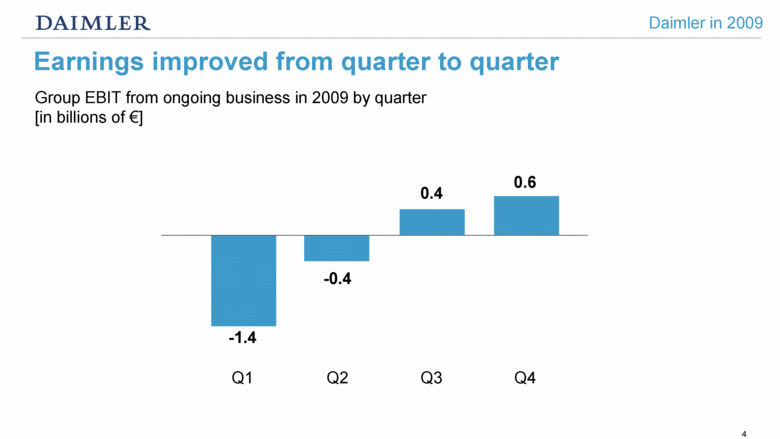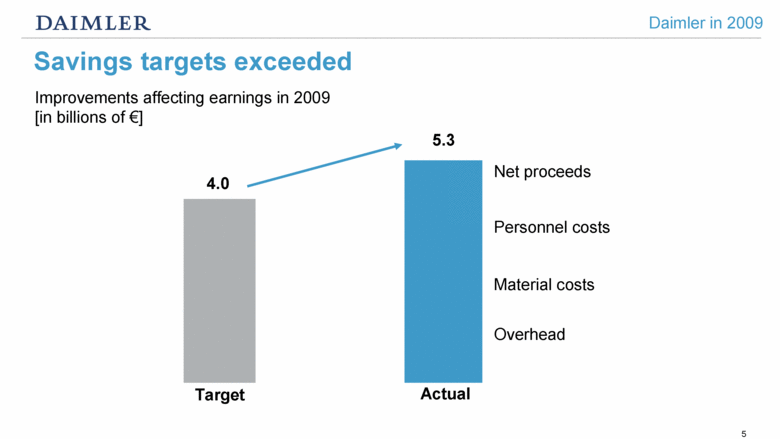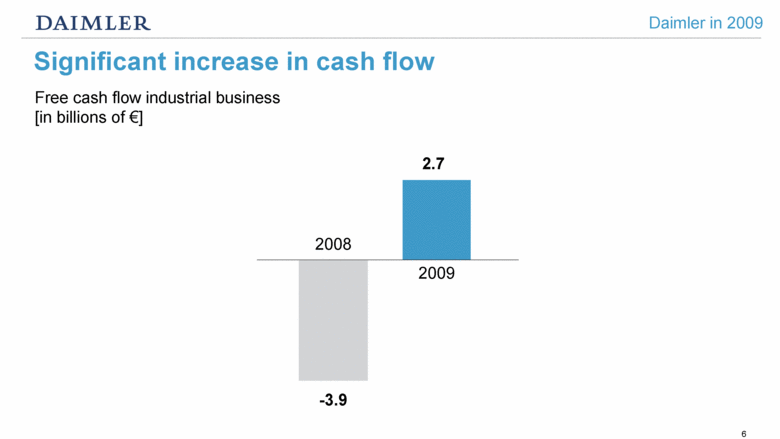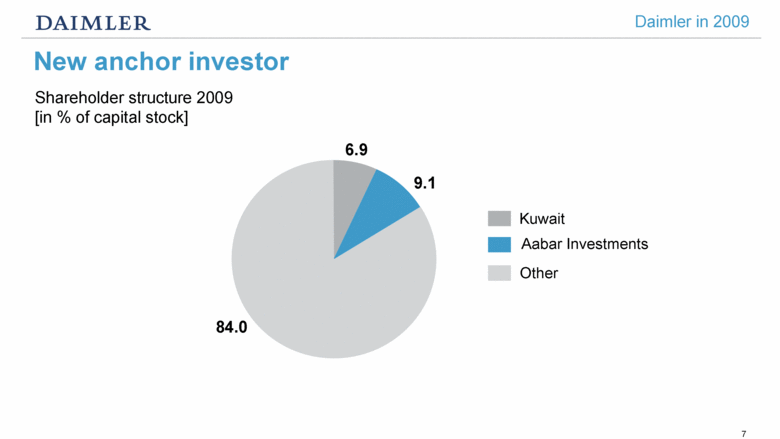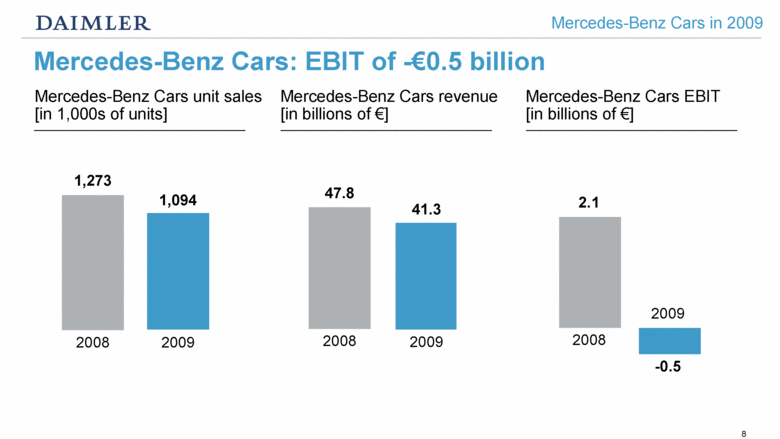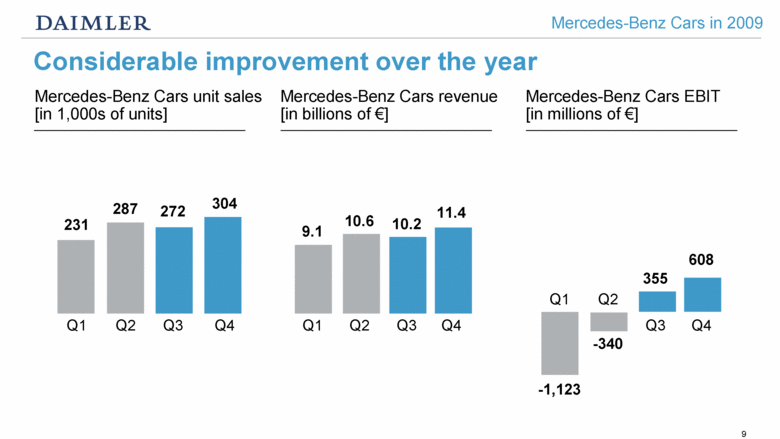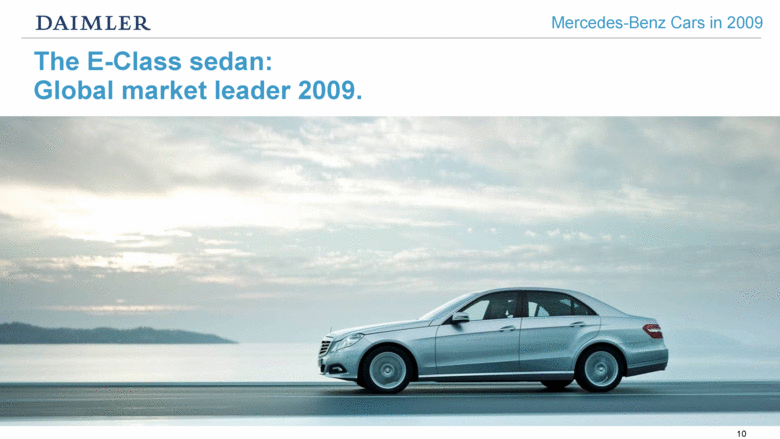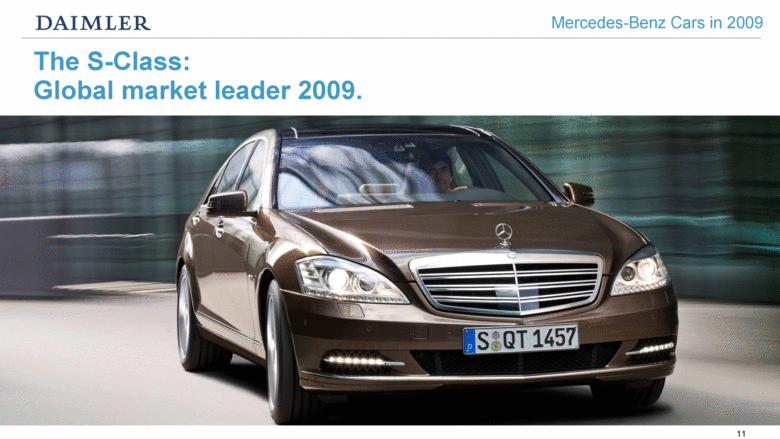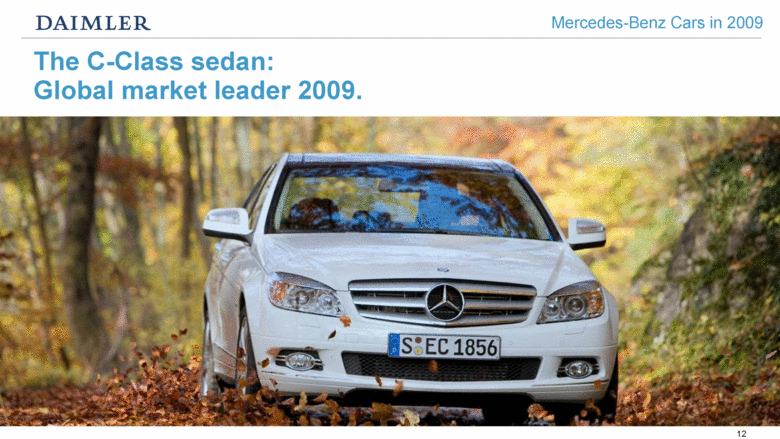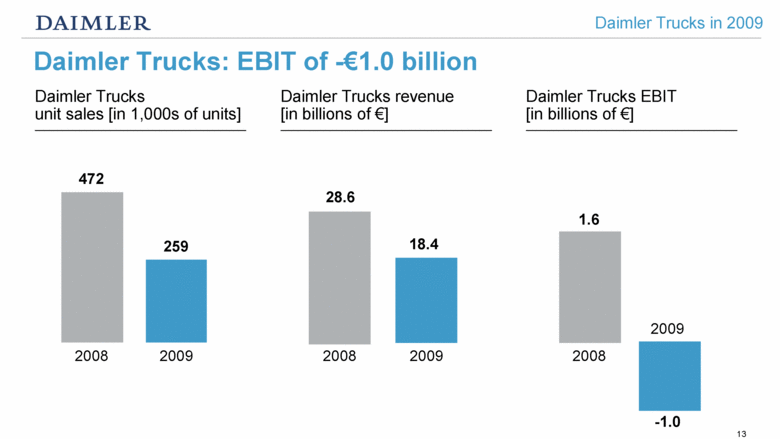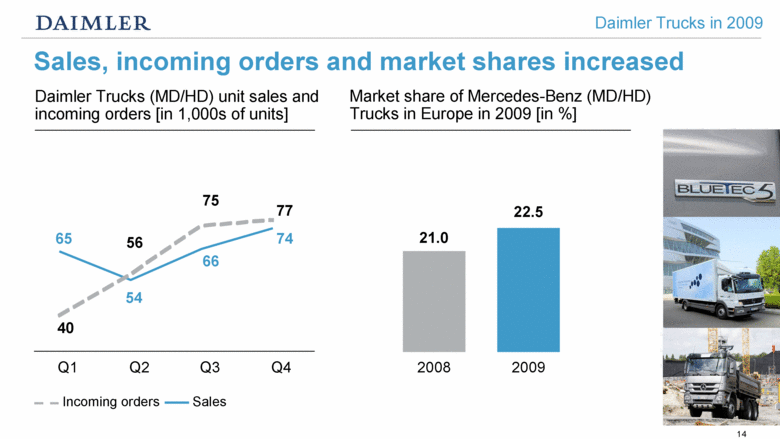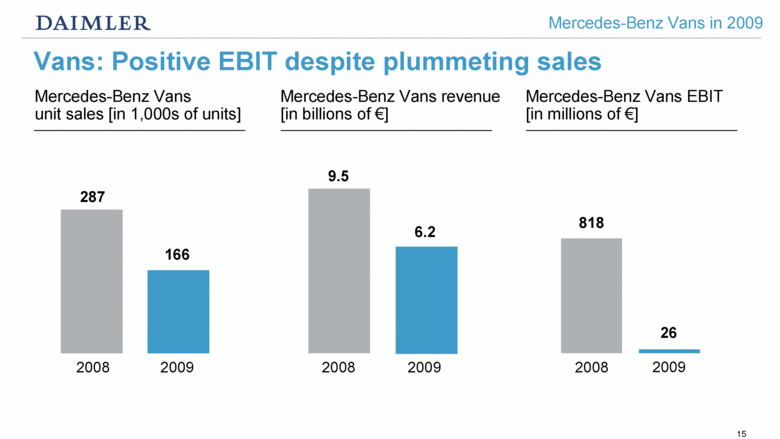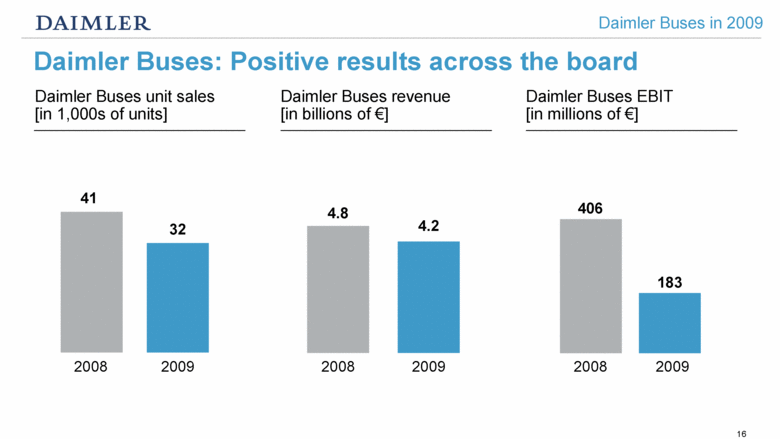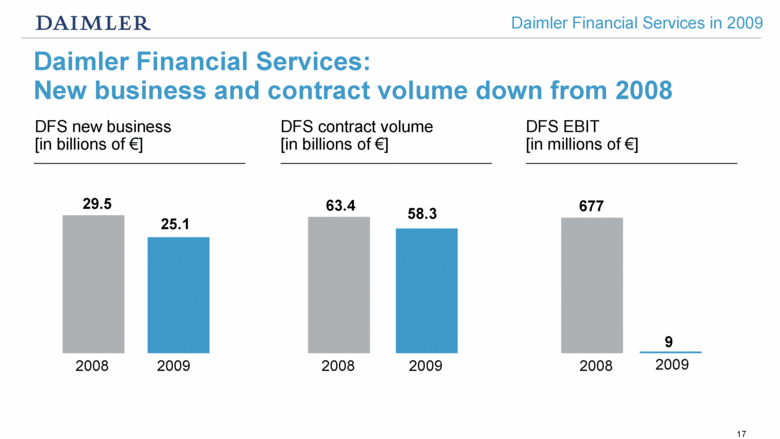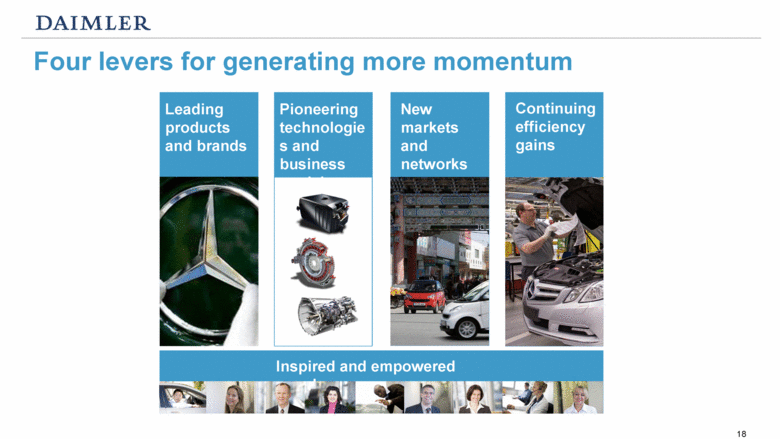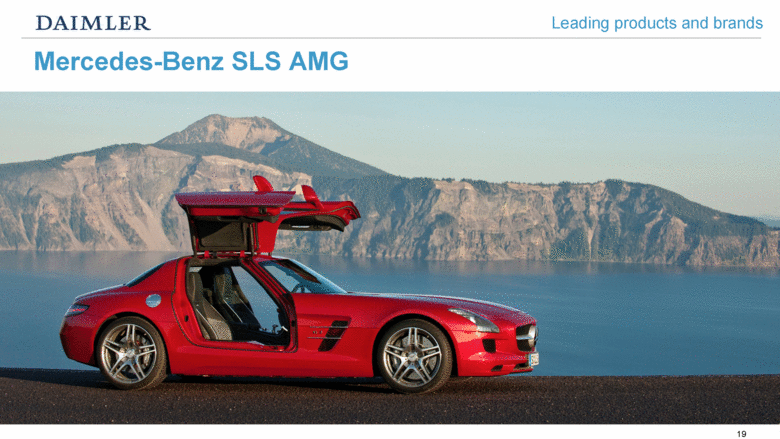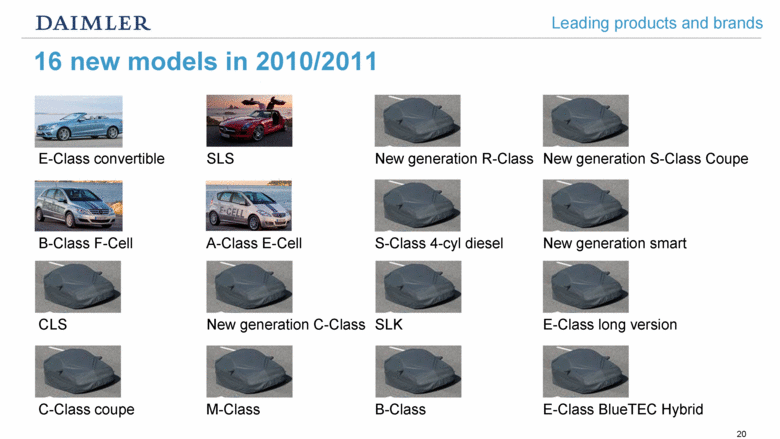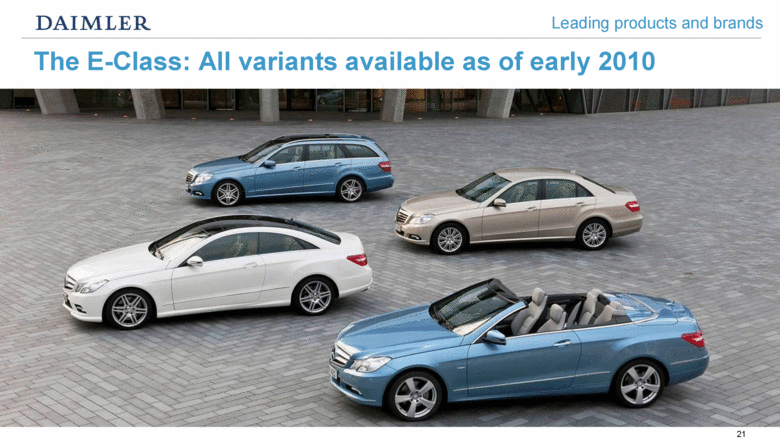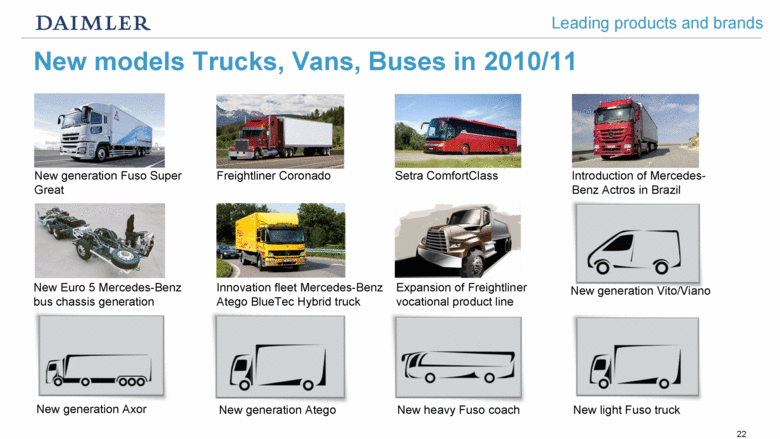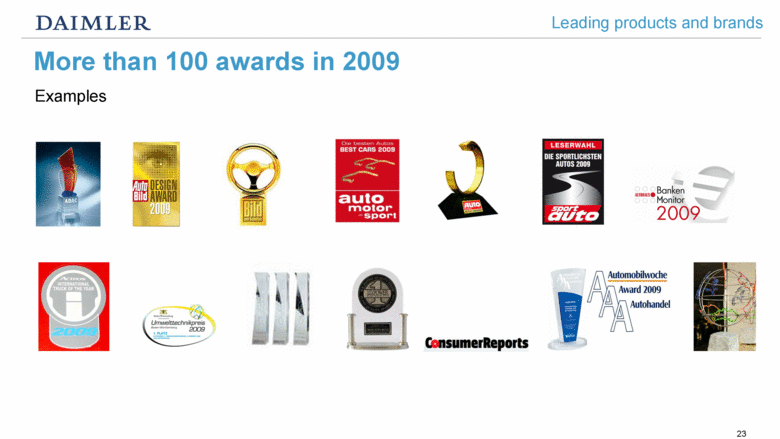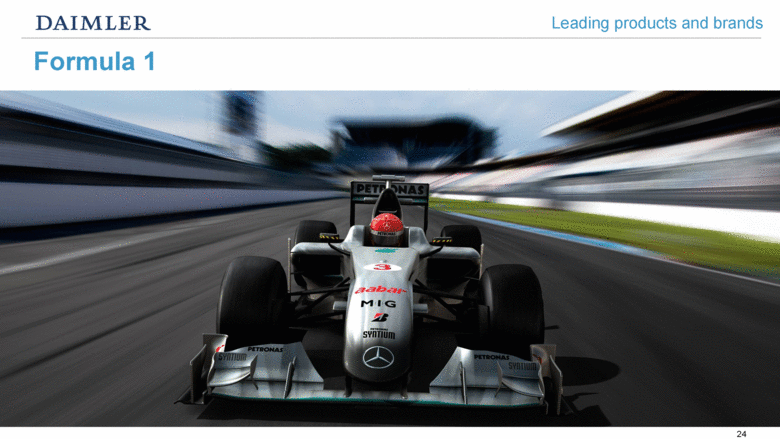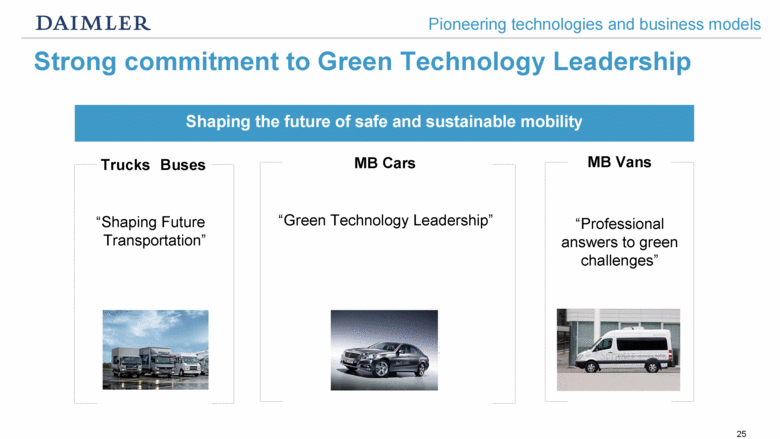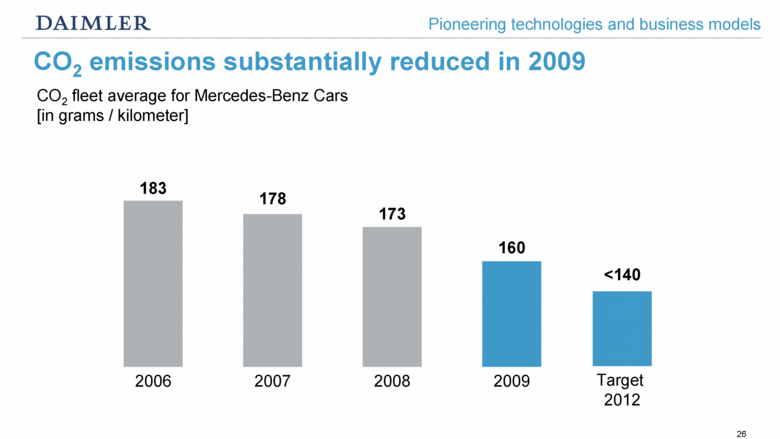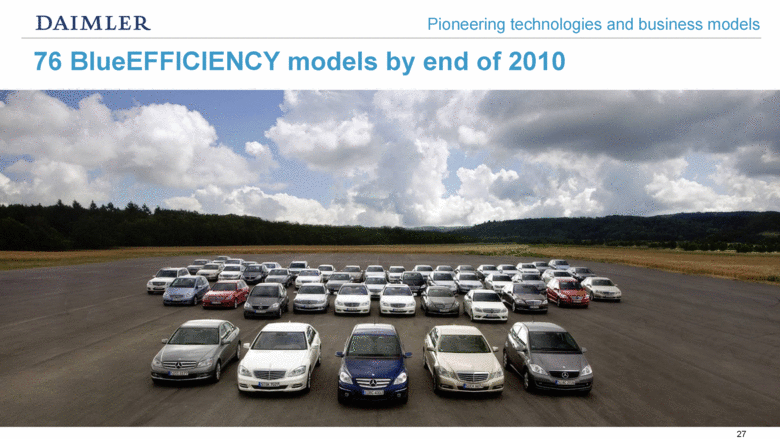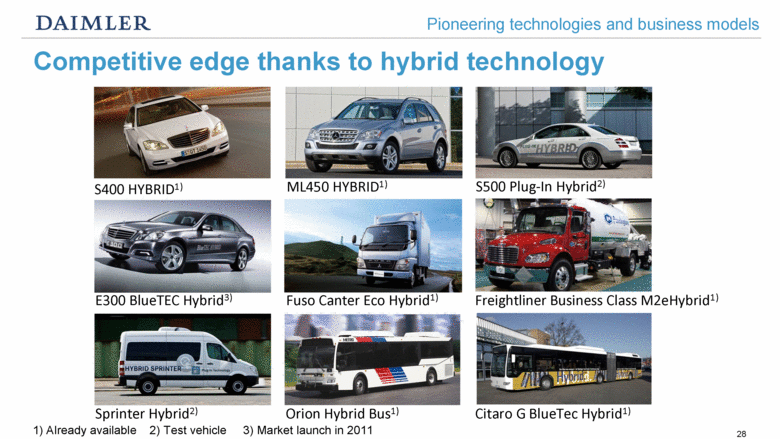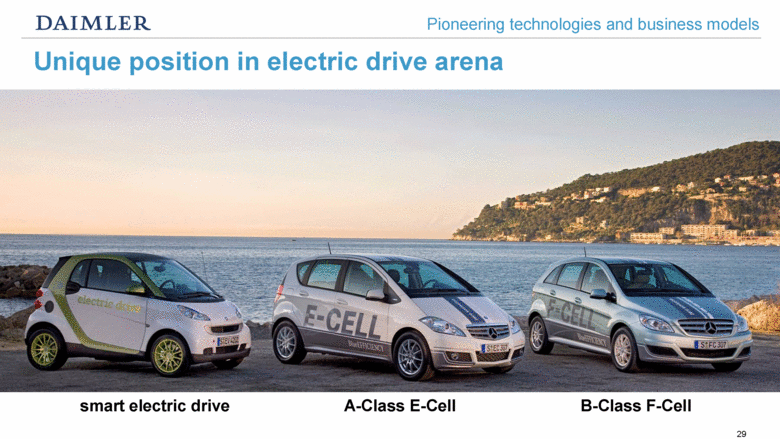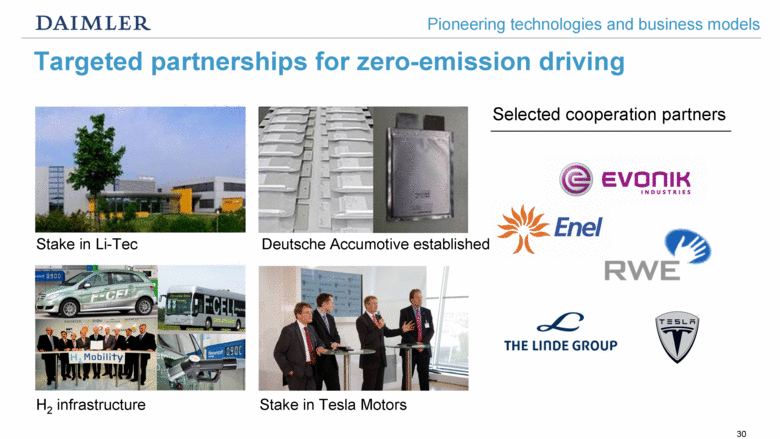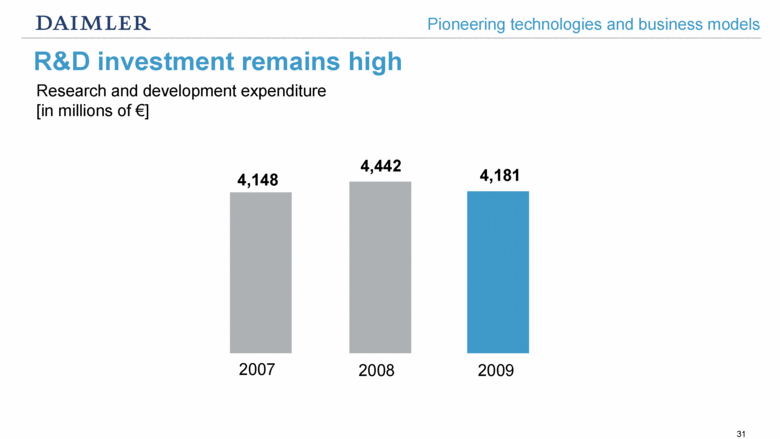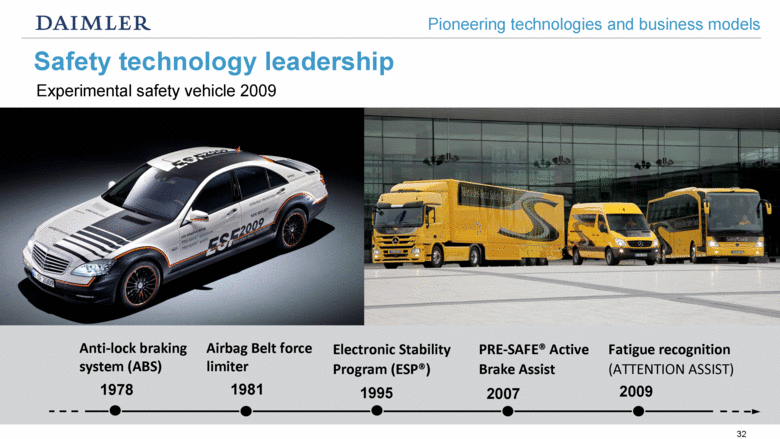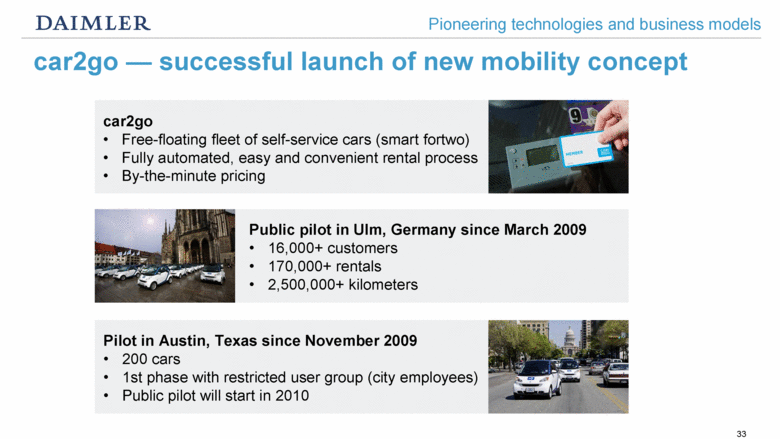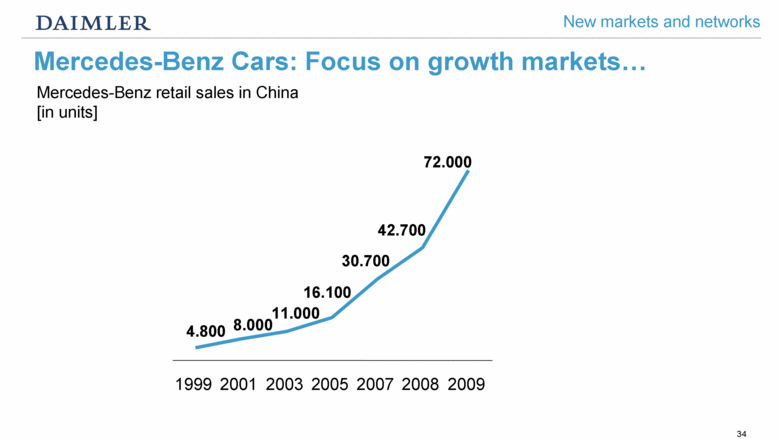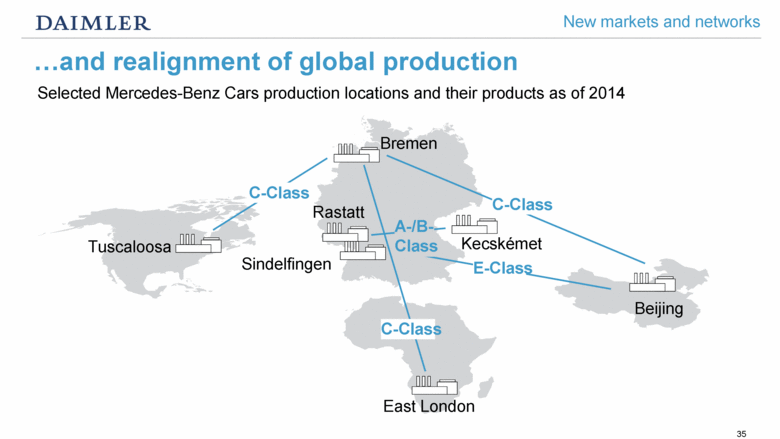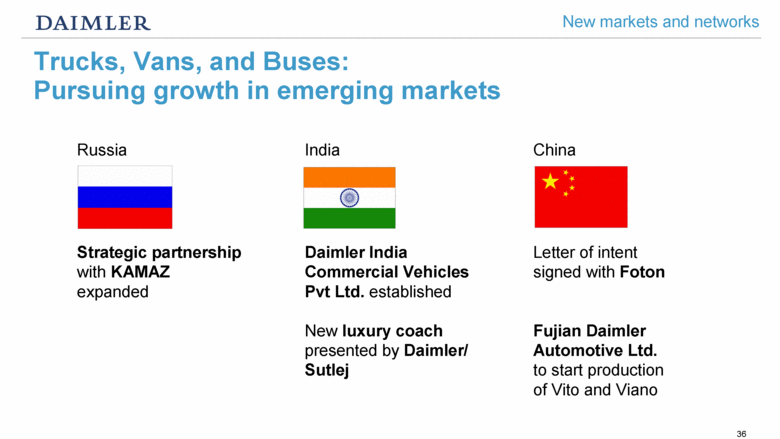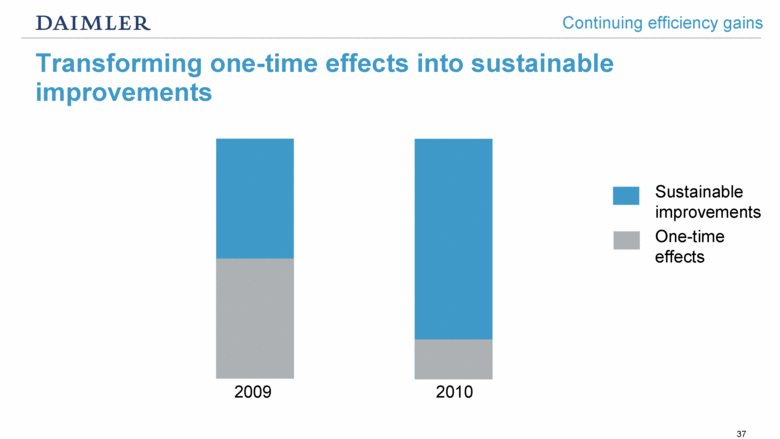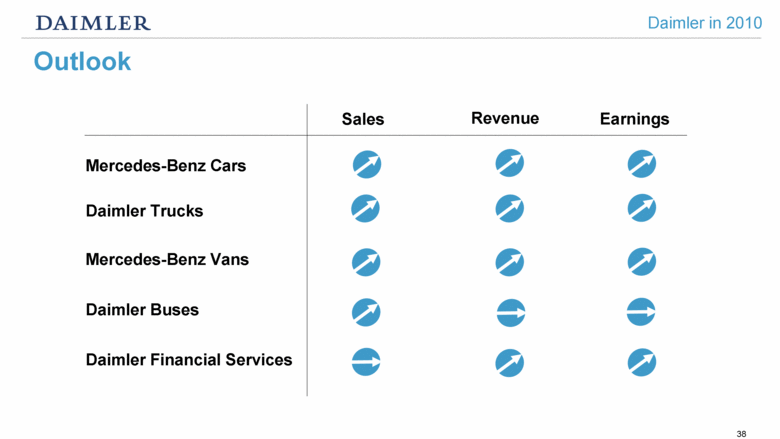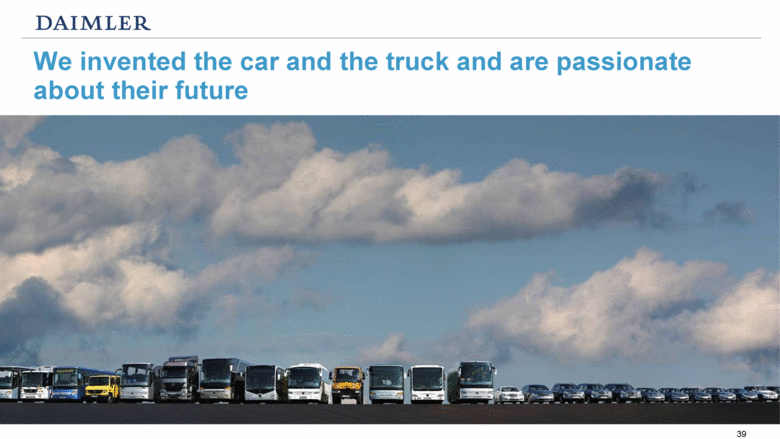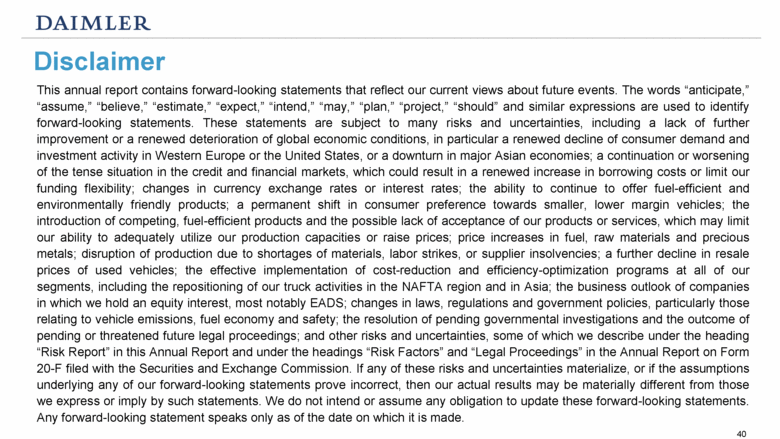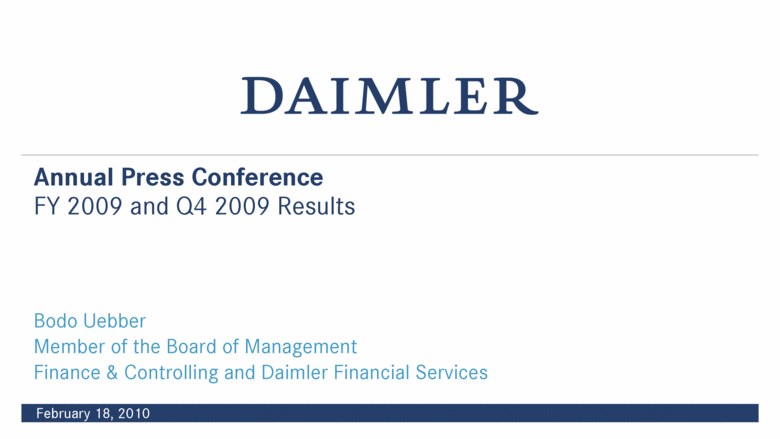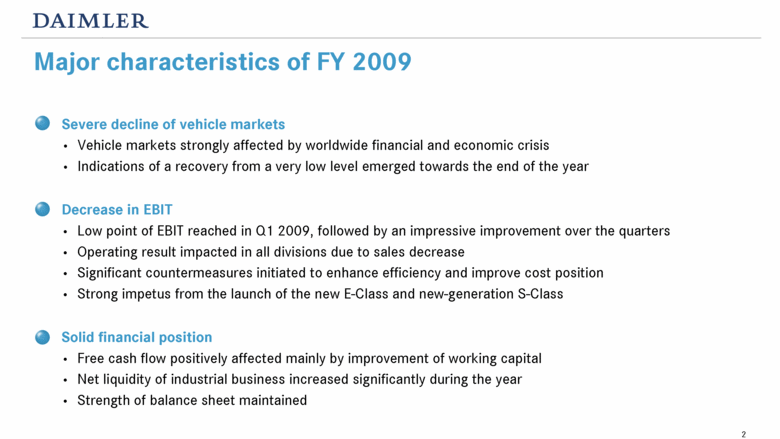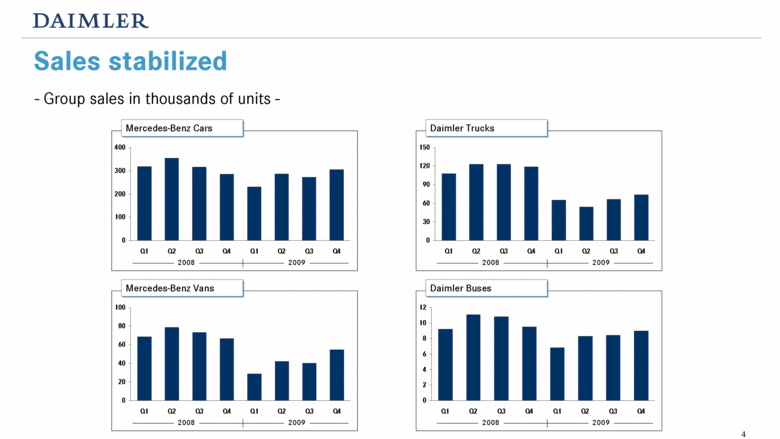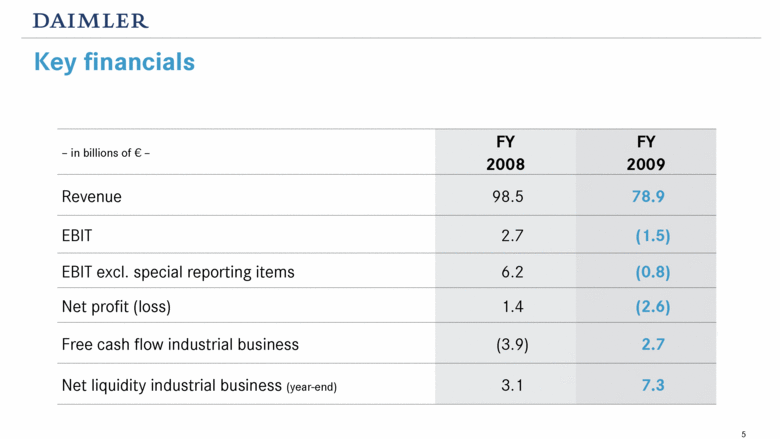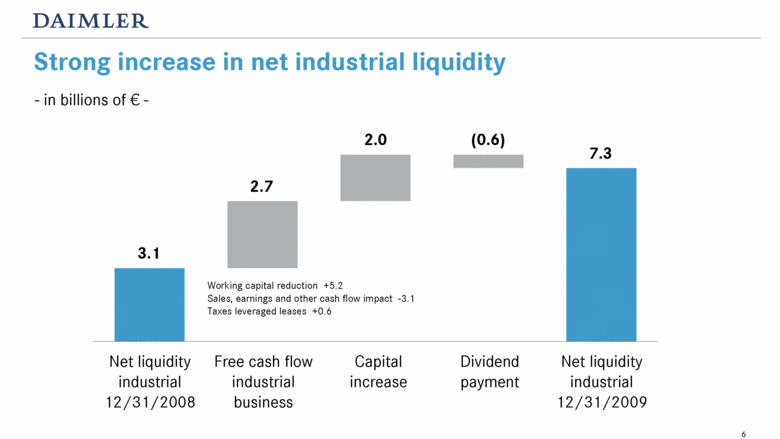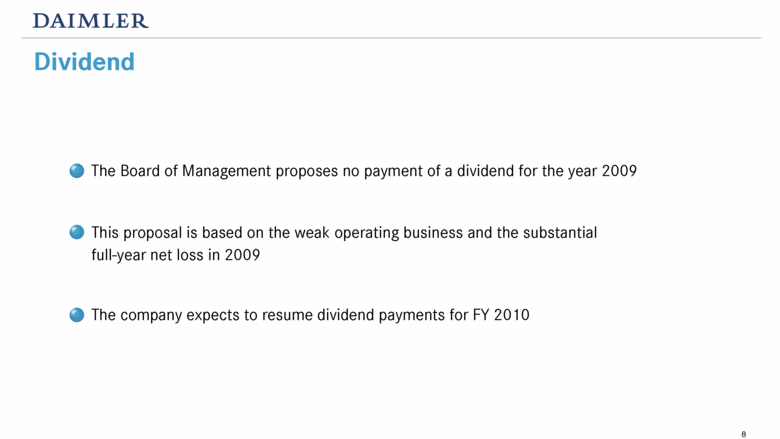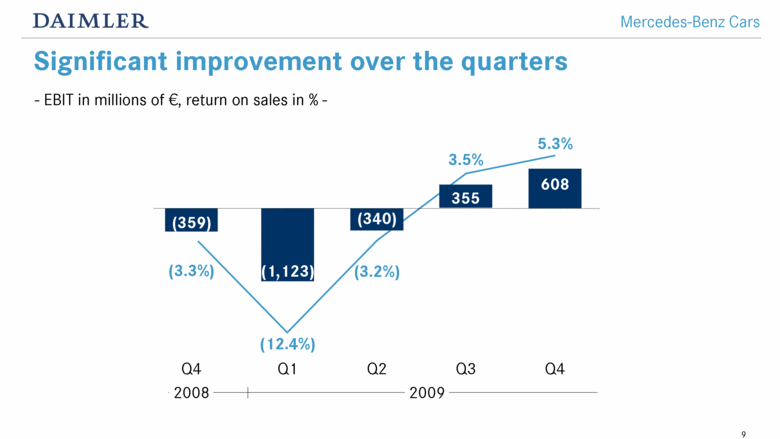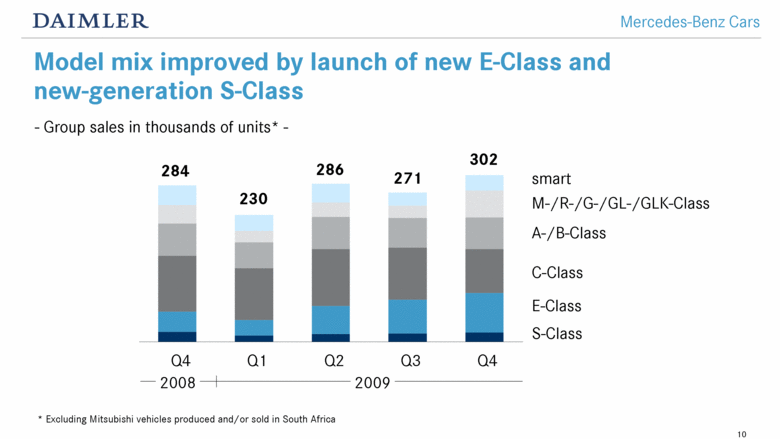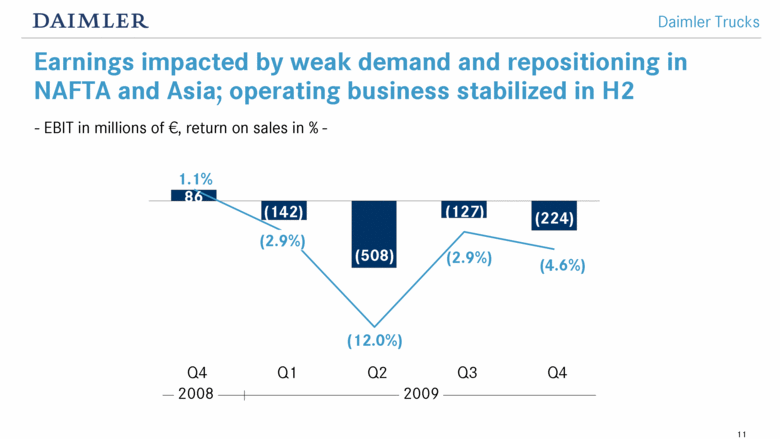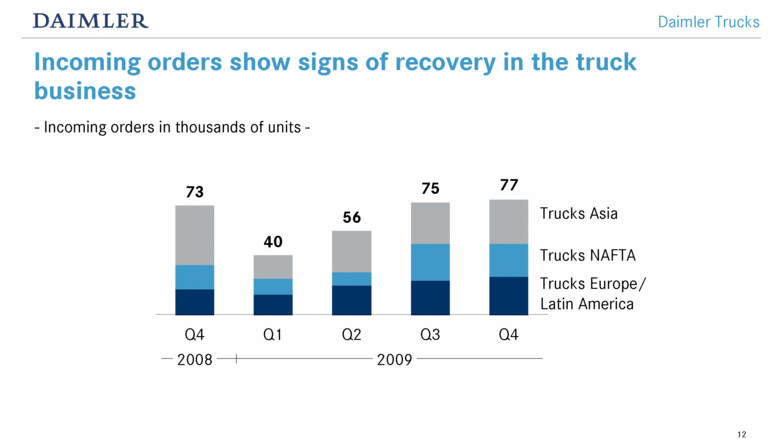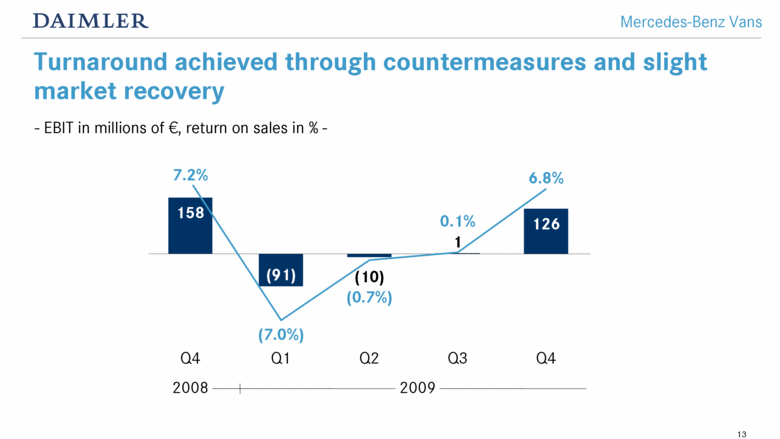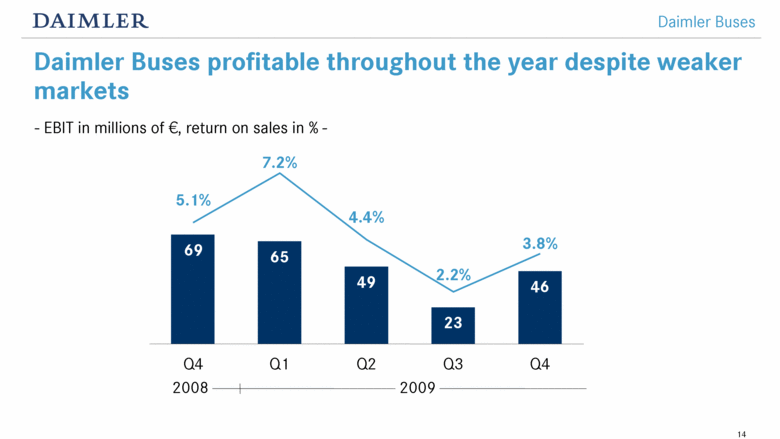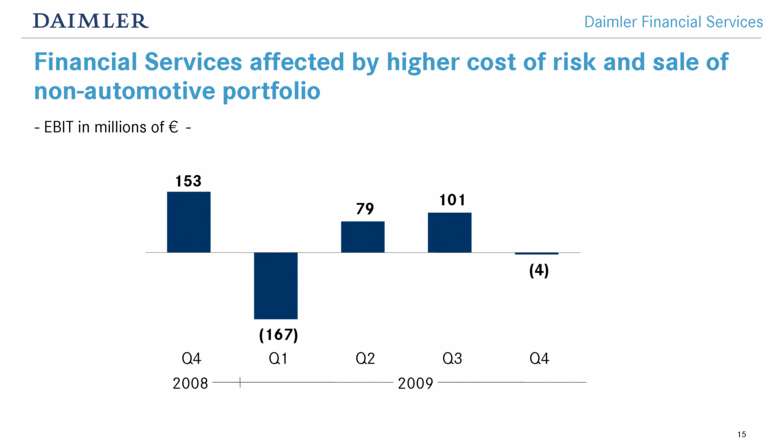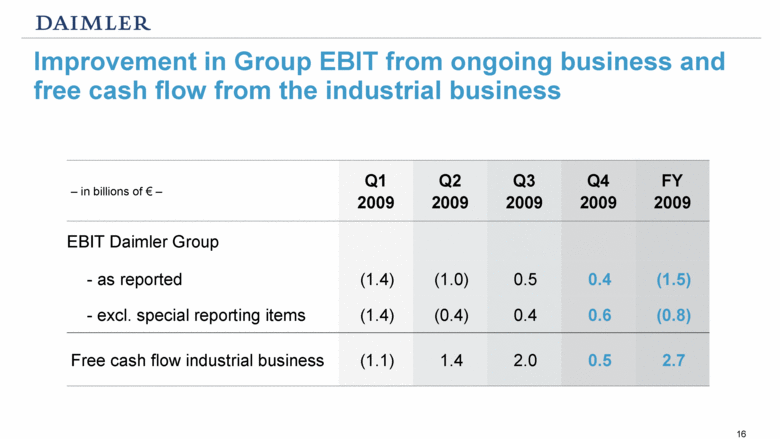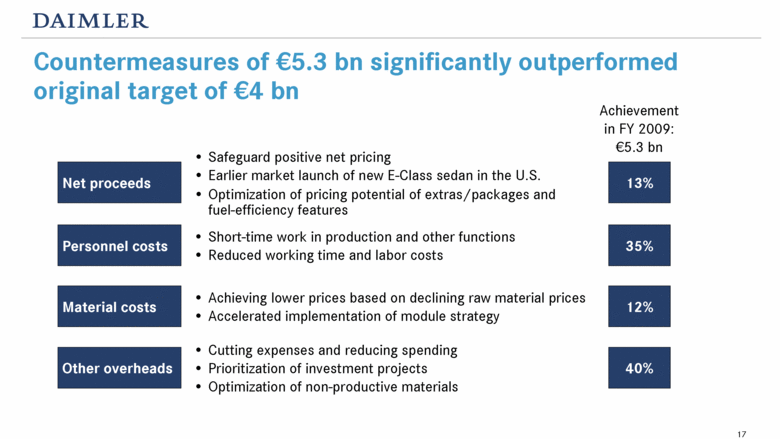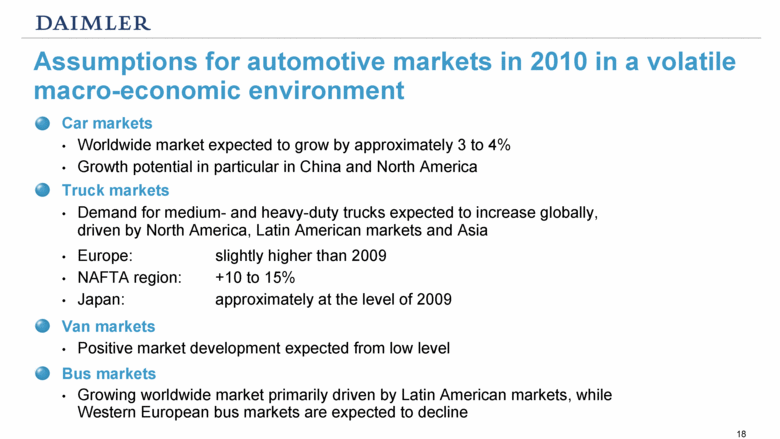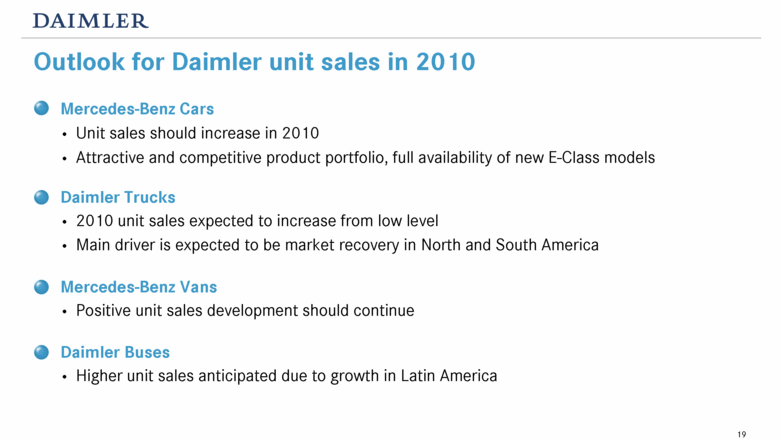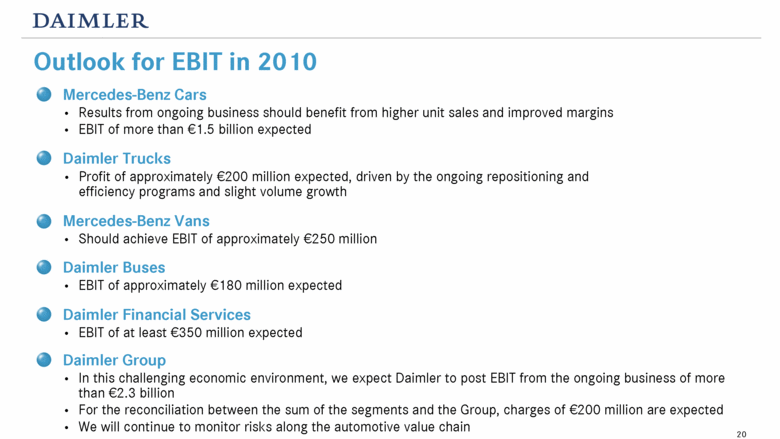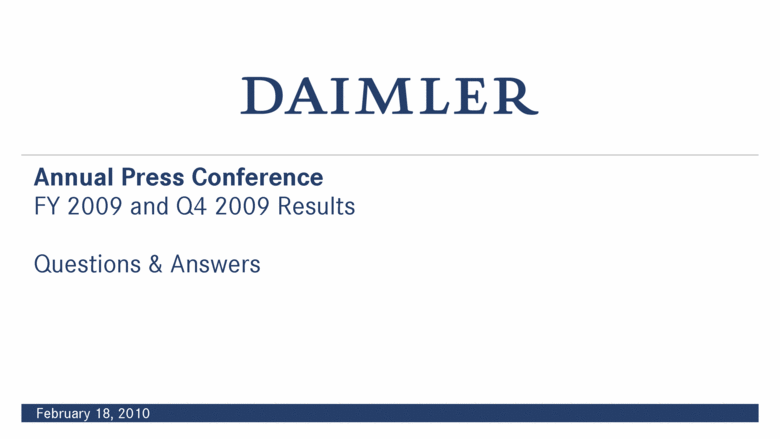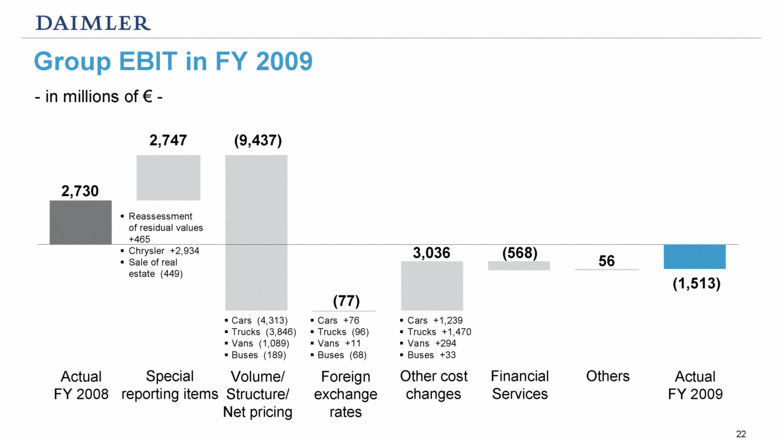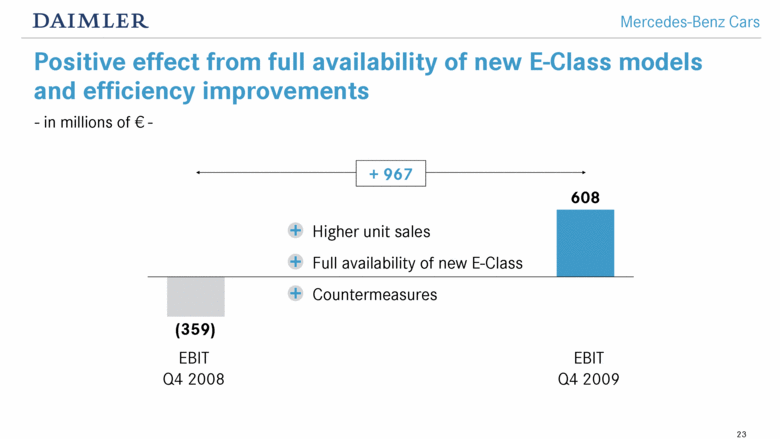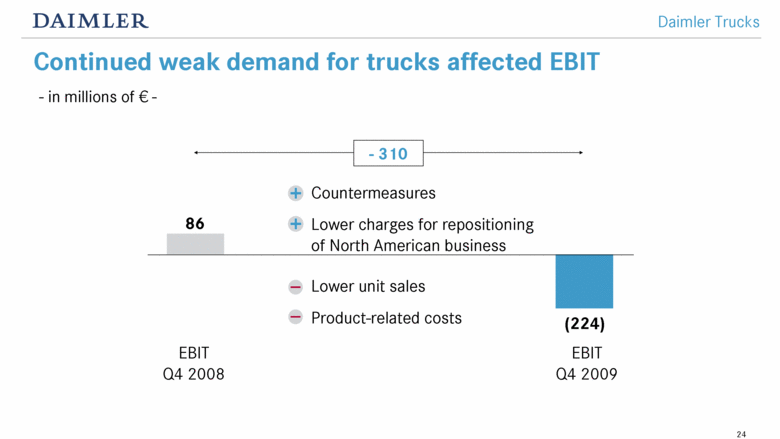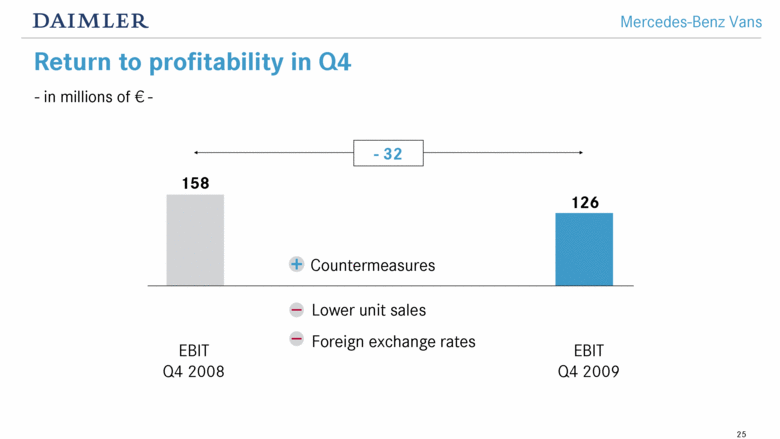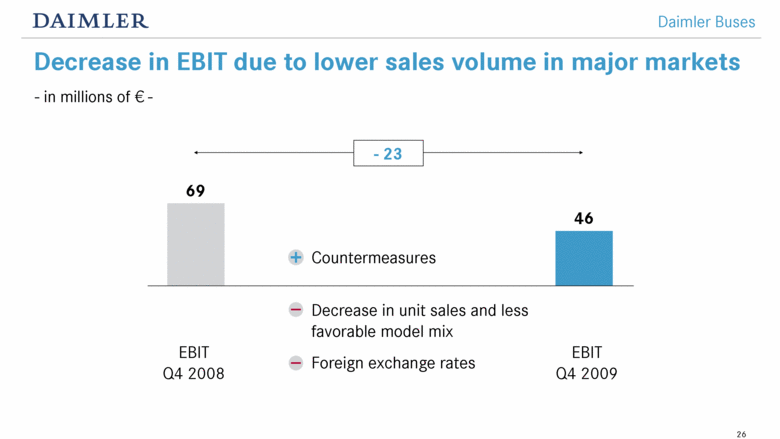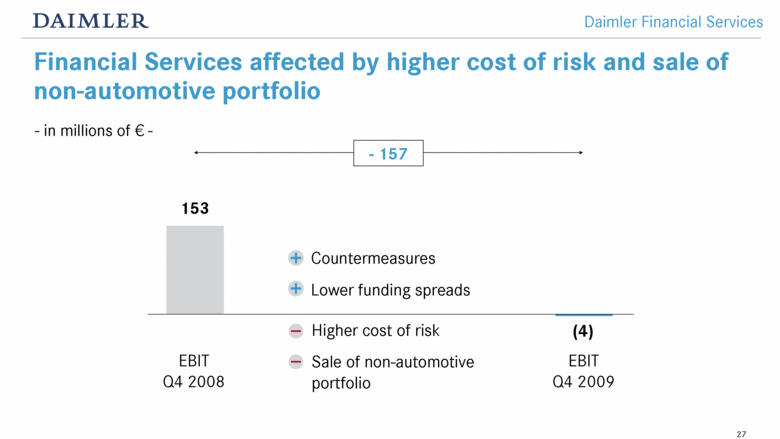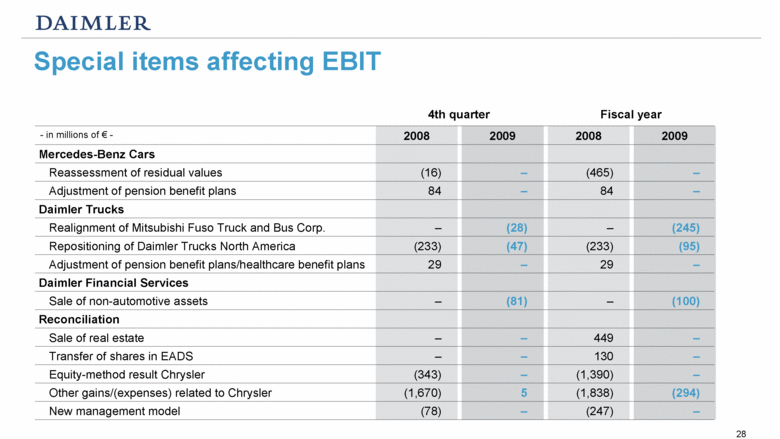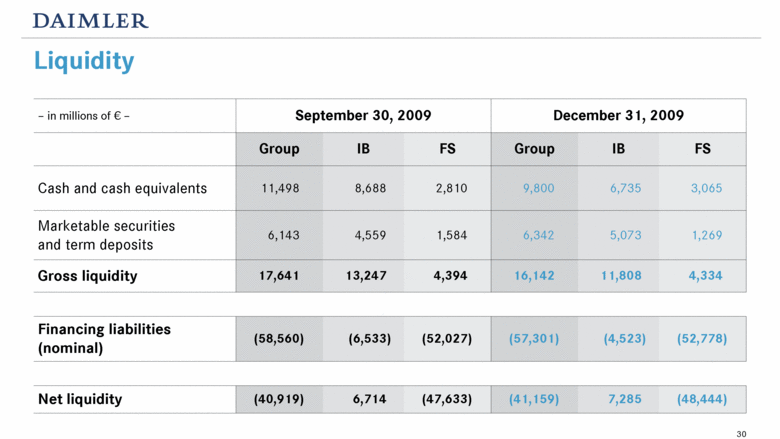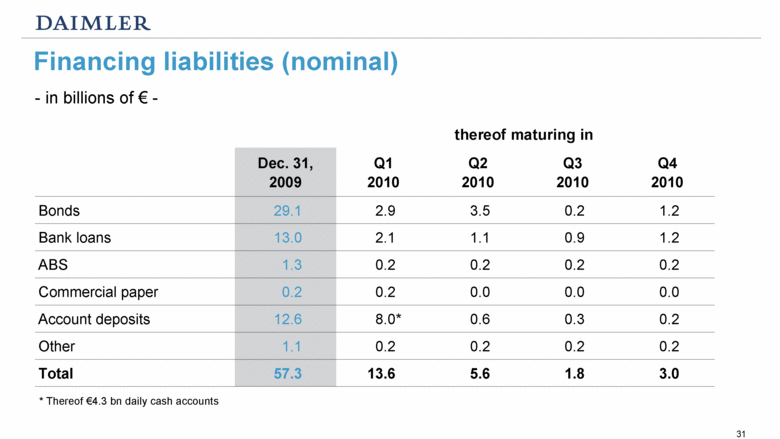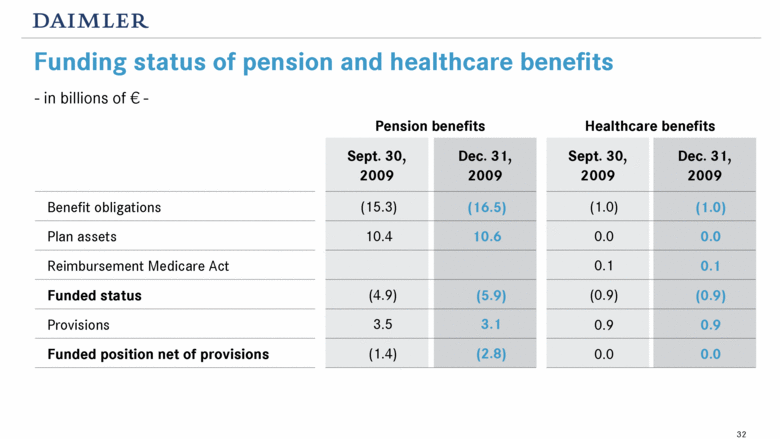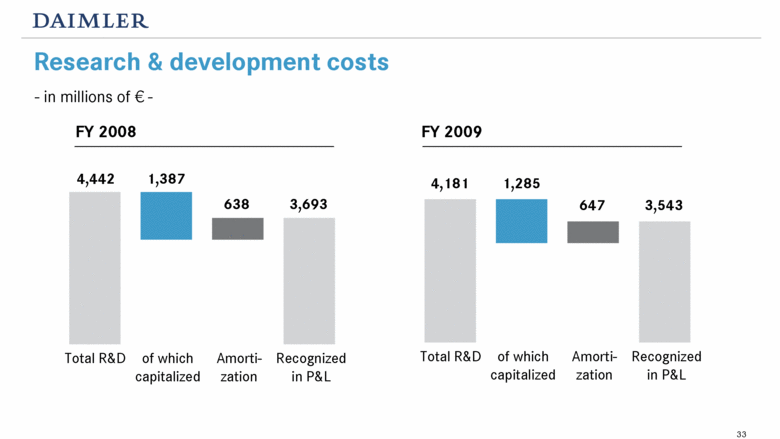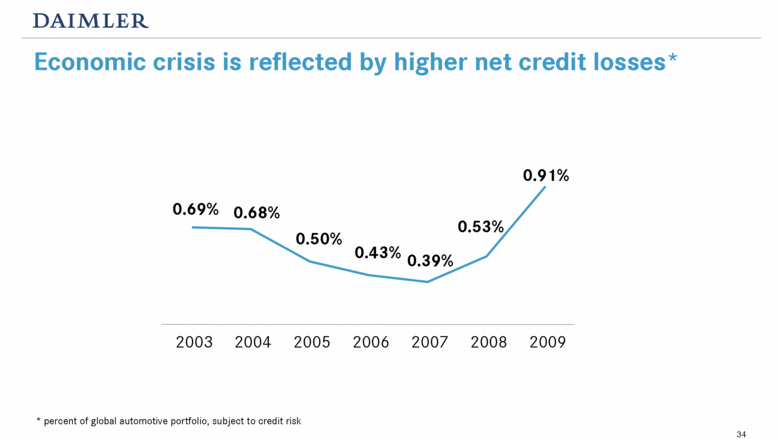SECURITIES AND EXCHANGE COMMISSION
Washington, D.C. 20549
Form 6-K
REPORT OF FOREIGN PRIVATE ISSUER
PURSUANT TO RULE 13a-16 OR 15d-16 UNDER
THE SECURITIES EXCHANGE ACT OF 1934
February 18, 2010
Commission File Number 1-12356
DAIMLER AG
(Translation of registrant’s name into English)
MERCEDESSTRASSE 137, 70327 STUTTGART, GERMANY
(Address of principal executive office)
Indicate by check mark whether the registrant files or will file annual reports under cover of Form 20-F or Form 40-F.
Form 20-F | x |
| Form 40-F o |
Indicate by check mark whether the registrant by furnishing the information contained in this Form is also thereby furnishing the information to the Commission pursuant to Rule 12g3-2(b) under the Securities Exchange Act of 1934.
Yes | o |
| No x |
If “Yes” is marked, indicate below the file number assigned to the registrant in connection with Rule 12g3-2(b): 82-
DAIMLER AG
| |
1. | Presentation Dr. Dieter Zetsche |
|
|
2. | Speech by Dr. Dieter Zetsche |
|
|
3. | Presentation Bodo Uebber |
|
|
4. | Speech by Bodo Uebber |
|
|
5. | Fact Sheets |
CAUTIONARY STATEMENT REGARDING FORWARD-LOOKING STATEMENTS
Forward-looking statements in this document:
The figures in this document are preliminary and have neither been yet approved by the Supervisory Board nor audited by the external auditor.
This document contains forward-looking statements that reflect our current views about future events. The words “anticipate,” “assume,” “believe,” “estimate,” “expect,” “intend,” “may,” “plan,” “project,” “should” and similar expressions are used to identify forward-looking statements. These statements are subject to many risks and uncertainties, including a lack of further improvement or a renewed deterioration of global economic conditions, in particular a renewed decline of consumer demand and investment activity in Western Europe or the United States, or a downturn in major Asian economies; a continuation or worsening of the tense situation in the credit and financial markets, which could result in a renewed increase in borrowing costs or limit our funding flexibility; changes in currency exchange rates or interest rates; the ability to continue to offer fuel-efficient and environmentally friendly products; a permanent shift in consumer preference towards smaller, lower margin vehicles; the introduction of competing, fuel-efficient products and the possible lack of acceptance of our products or services, which may limit our ability to adequately utilize our production capacities or raise prices; price increases in fuel, raw materials and precious metals; disruption of production due to shortages of materials, labor strikes, or supplier insolvencies; a further decline in resale prices of used vehicles; the effective implementation of cost-reduction and efficiency-optimization programs at all of our segments, including the repositioning of our truck activities in the NAFTA region and in Asia; the business outlook of companies in which we hold an equity interest, most notably EADS; changes in laws, regulations and government policies, particularly those relating to vehicle emissions, fuel economy and safety, the resolution of pending governmental investigations and the outcome of pending or threatened future legal proceedings; and other risks and uncertainties, some of which we describe under the heading “Risk Report” in Daimler’s most recent Annual Report and under the headings “Risk Factors” and “Legal Proceedings” in Daimler’s most recent Annual Report on Form 20-F filed with the Securities and Exchange Commission. If any of these risks and uncertainties materialize, or if the assumptions underlying any of our forward-looking statements prove incorrect, then our actual results may be materially different from those we express or imply by such statements. We do not intend or assume any obligation to update these forward-looking statements. Any forward-looking statement speaks only as of the date on which it is made.
1
| Annual Press Conference 2009 Results Dr. Dieter Zetsche Chairman of the Board of Management Head of Mercedes-Benz Cars |
| Global economy contracts for first time in 60 years 1950 1955 1960 1965 1970 1975 1980 1985 1990 1995 2000 2005 2009 -2.1 5.9 0.8 0.2 1.3 Global economy in 2009 Real GDP growth [% change p.a.] |
| (2.6) 1.4 (1.5) 2.7 78.9 98.5 0.00 0.60 FY 2009 FY 2008 2.7 (3.9) Daimler: EBIT of -€1.5 billion -100 - - - -20 % change Net profit (loss) EBIT Revenue Dividend (in EUR) – in billions of € – Daimler in 2009 Free cash flow industrial business |
| Earnings improved from quarter to quarter Daimler in 2009 -1.4 -0.4 0.4 Q1 Q2 Q3 Q4 0.6 Group EBIT from ongoing business in 2009 by quarter [in billions of €] |
| Savings targets exceeded Daimler in 2009 Target Actual Overhead Net proceeds Personnel costs Material costs 5.3 4.0 Improvements affecting earnings in 2009 [in billions of €] |
| Significant increase in cash flow Daimler in 2009 2008 2009 -3.9 2.7 Free cash flow industrial business [in billions of €] |
| New anchor investor Daimler in 2009 Aabar Investments Kuwait Other 6.9 9.1 84.0 Shareholder structure 2009 [in % of capital stock] |
| Mercedes-Benz Cars: EBIT of -€0.5 billion Mercedes-Benz Cars in 2009 1,273 1,094 2008 2009 47.8 41.3 2008 2009 2.1 -0.5 2008 2009 Mercedes-Benz Cars unit sales [in 1,000s of units] Mercedes-Benz Cars revenue [in billions of €] Mercedes-Benz Cars EBIT [in billions of €] |
| Considerable improvement over the year Mercedes-Benz Cars in 2009 -1,123 355 608 -340 Q1 Q2 Q3 Q4 9.1 10.2 11.4 10.6 Q1 Q2 Q3 Q4 Mercedes-Benz Cars unit sales [in 1,000s of units] Mercedes-Benz Cars revenue [in billions of €] Mercedes-Benz Cars EBIT [in millions of €] 231 304 287 Q1 Q2 Q3 Q4 272 |
| The E-Class sedan: Global market leader 2009. Mercedes-Benz Cars in 2009 10 |
| The S-Class: Global market leader 2009. Mercedes-Benz Cars in 2009 11 |
| The C-Class sedan: Global market leader 2009. Mercedes-Benz Cars in 2009 12 |
| Daimler Trucks: EBIT of -€1.0 billion Daimler Trucks in 2009 472 259 2008 2009 28.6 18.4 2008 2009 1.6 2008 2009 -1.0 Daimler Trucks unit sales [in 1,000s of units] Daimler Trucks revenue [in billions of €] Daimler Trucks EBIT [in billions of €] |
| Sales, incoming orders and market shares increased Daimler Trucks in 2009 Market share of Mercedes-Benz (MD/HD) Trucks in Europe in 2009 [in %] 21.0 22.5 2008 2009 40 56 75 77 74 65 54 66 Q1 Q2 Q3 Q4 Sales Incoming orders Daimler Trucks (MD/HD) unit sales and incoming orders [in 1,000s of units] |
| Vans: Positive EBIT despite plummeting sales 287 166 2008 2009 9.5 6.2 2008 2009 818 26 2008 2009 Mercedes-Benz Vans in 2009 Mercedes-Benz Vans unit sales [in 1,000s of units] Mercedes-Benz Vans revenue [in billions of €] Mercedes-Benz Vans EBIT [in millions of €] |
| Daimler Buses: Positive results across the board 41 32 2008 2009 2008 2009 406 183 2008 2009 4.8 4.2 Daimler Buses unit sales [in 1,000s of units] Daimler Buses revenue [in billions of €] Daimler Buses EBIT [in millions of €] Daimler Buses in 2009 |
| Daimler Financial Services: New business and contract volume down from 2008 29.5 2008 2009 63.4 2008 2009 25.1 Daimler Financial Services in 2009 677 9 2008 2009 DFS new business [in billions of €] DFS contract volume [in billions of €] DFS EBIT [in millions of €] 58.3 |
| Four levers for generating more momentum Leading products and brands Pioneering technologies and business models New markets and networks Continuing efficiency gains Inspired and empowered people |
| Mercedes-Benz SLS AMG Leading products and brands |
| 16 new models in 2010/2011 Leading products and brands New generation R-Class New generation S-Class Coupe SLS E-Class convertible S-Class 4-cyl diesel New generation smart A-Class E-Cell B-Class F-Cell SLK E-Class long version New generation C-Class CLS B-Class E-Class BlueTEC Hybrid M-Class C-Class coupe |
| Leading products and brands The E-Class: All variants available as of early 2010 |
| New models Trucks, Vans, Buses in 2010/11 Leading products and brands New generation Vito/Viano New generation Fuso Super Great Freightliner Coronado New generation Axor New generation Atego Setra ComfortClass New light Fuso truck Expansion of Freightliner vocational product line Innovation fleet Mercedes-Benz Atego BlueTec Hybrid truck New heavy Fuso coach Introduction of Mercedes-Benz Actros in Brazil New Euro 5 Mercedes-Benz bus chassis generation |
| More than 100 awards in 2009 Examples Leading products and brands 23 |
| Formula 1 Leading products and brands |
| Strong commitment to Green Technology Leadership Pioneering technologies and business models “Green Technology Leadership” “Shaping Future Transportation” “Professional answers to green challenges” Shaping the future of safe and sustainable mobility MB Cars MB Vans Trucks Buses |
| CO2 emissions substantially reduced in 2009 CO2 fleet average for Mercedes-Benz Cars [in grams / kilometer] 160 178 173 183 2006 2007 2008 2009 <140 Target 2012 Pioneering technologies and business models |
| 76 BlueEFFICIENCY models by end of 2010 Pioneering technologies and business models |
| Competitive edge thanks to hybrid technology 1) Already available 2) Test vehicle 3) Market launch in 2011 Pioneering technologies and business models S400 HYBRID1) S500 Plug-In Hybrid2) ML450 HYBRID1) Fuso Canter Eco Hybrid1) Sprinter Hybrid2) E300 BlueTEC Hybrid3) Freightliner Business Class M2eHybrid1) Orion Hybrid Bus1) Citaro G BlueTec Hybrid1) 28 |
| Unique position in electric drive arena smart electric drive B-Class F-Cell A-Class E-Cell Pioneering technologies and business models |
| Targeted partnerships for zero-emission driving Pioneering technologies and business models Stake in Li-Tec Stake in Tesla Motors H2 infrastructure Deutsche Accumotive established Selected cooperation partners |
| R&D investment remains high Research and development expenditure [in millions of €] 4,148 4,442 4,181 2007 2008 2009 Pioneering technologies and business models |
| PRE-SAFE® Active Brake Assist Fatigue recognition (ATTENTION ASSIST) Electronic Stability Program (ESP®) Anti-lock braking system (ABS) Airbag Belt force limiter 1978 1981 1995 2007 2009 Pioneering technologies and business models Safety technology leadership Experimental safety vehicle 2009 |
| car2go — successful launch of new mobility concept Pioneering technologies and business models car2go Free-floating fleet of self-service cars (smart fortwo) Fully automated, easy and convenient rental process By-the-minute pricing Public pilot in Ulm, Germany since March 2009 16,000+ customers 170,000+ rentals 2,500,000+ kilometers Pilot in Austin, Texas since November 2009 200 cars 1st phase with restricted user group (city employees) Public pilot will start in 2010 |
| Mercedes-Benz Cars: Focus on growth markets... New markets and networks Mercedes-Benz retail sales in China [in units] 4.800 8.000 11.000 16.100 30.700 42.700 72.000 1999 2001 2003 2005 2007 2008 2009 |
| ...and realignment of global production Selected Mercedes-Benz Cars production locations and their products as of 2014 New markets and networks East London Beijing Tuscaloosa Sindelfingen Rastatt Bremen E-Class C-Class C-Class Kecskémet A-/B- Class C-Class |
| Trucks, Vans, and Buses: Pursuing growth in emerging markets Russia Strategic partnership with KAMAZ expanded New markets and networks India Daimler India Commercial Vehicles Pvt Ltd. established New luxury coach presented by Daimler/ Sutlej China Letter of intent signed with Foton Fujian Daimler Automotive Ltd. to start production of Vito and Viano |
| Transforming one-time effects into sustainable improvements Continuing efficiency gains One-time effects Sustainable improvements 2009 2010 |
| Outlook Sales Revenue Earnings Mercedes-Benz Cars Daimler Trucks Mercedes-Benz Vans Daimler Buses Daimler Financial Services Daimler in 2010 |
| We invented the car and the truck and are passionate about their future |
| Disclaimer This annual report contains forward-looking statements that reflect our current views about future events. The words “anticipate,” “assume,” ��believe,” “estimate,” “expect,” “intend,” “may,” “plan,” “project,” “should” and similar expressions are used to identify forward-looking statements. These statements are subject to many risks and uncertainties, including a lack of further improvement or a renewed deterioration of global economic conditions, in particular a renewed decline of consumer demand and investment activity in Western Europe or the United States, or a downturn in major Asian economies; a continuation or worsening of the tense situation in the credit and financial markets, which could result in a renewed increase in borrowing costs or limit our funding flexibility; changes in currency exchange rates or interest rates; the ability to continue to offer fuel-efficient and environmentally friendly products; a permanent shift in consumer preference towards smaller, lower margin vehicles; the introduction of competing, fuel-efficient products and the possible lack of acceptance of our products or services, which may limit our ability to adequately utilize our production capacities or raise prices; price increases in fuel, raw materials and precious metals; disruption of production due to shortages of materials, labor strikes, or supplier insolvencies; a further decline in resale prices of used vehicles; the effective implementation of cost-reduction and efficiency-optimization programs at all of our segments, including the repositioning of our truck activities in the NAFTA region and in Asia; the business outlook of companies in which we hold an equity interest, most notably EADS; changes in laws, regulations and government policies, particularly those relating to vehicle emissions, fuel economy and safety; the resolution of pending governmental investigations and the outcome of pending or threatened future legal proceedings; and other risks and uncertainties, some of which we describe under the heading “Risk Report” in this Annual Report and under the headings “Risk Factors” and “Legal Proceedings” in the Annual Report on Form 20-F filed with the Securities and Exchange Commission. If any of these risks and uncertainties materialize, or if the assumptions underlying any of our forward-looking statements prove incorrect, then our actual results may be materially different from those we express or imply by such statements. We do not intend or assume any obligation to update these forward-looking statements. Any forward-looking statement speaks only as of the date on which it is made. |
2
Speech by
Dr. Dieter Zetsche
Chairman of the Board of Management
of Daimler AG
Annual Press Conference
Stuttgart
February 18, 2010
Introduction
Good morning, ladies and gentlemen. Welcome to our Annual Press Conference!
Today we’ll be reporting to you about a year that has been unusual — for the global economy, for the automotive industry, and also for Daimler. In 2009 the global economy contracted for the first time since 1950. This has been an abnormal recession, and it has hit the automotive industry particularly hard: Some of our markets plummeted in the short term by as much as 20 to 40 percent. In the truck markets, the downturn was in some cases even more severe.
Of course, these developments affected our business results: As we forecasted here twelve months ago, Daimler sold significantly fewer vehicles in 2009 than in the prior year. Altogether, we sold 1.6 million passenger cars, trucks, vans, and buses, and posted revenue of approximately 79 billion euros. Our EBIT from ongoing business operations was minus 1.5 billion euros. When all one-time effects are taken into account, it was minus 800 million euros. One-time charges resulted primarily: from the realignment of our truck business in the U.S. and Japan, as well as the divestment of our remaining shares in Chrysler. The Group’s net earnings were negative at minus 2.6 billion euros.
Given this unusual situation, the Board of Management is proposing to the Supervisory Board, by way of exception, that Daimler refrain from paying any dividends for the past business year. The proposal reflects only the business developments and the earnings situation in 2009. It does not have any implications for our current year’s business expectations. You can assume that we will once again pay a dividend for business year 2010.
Although our figures for 2009 were disappointing, it’s clear that 2009 was not a lost year for Daimler: In the course of the past year, we became significantly more efficient. Even though the markets remained weak, we increased our sales as the year progressed — particularly in the fourth quarter. And we did so more strongly than our competitors. Above all, we’ve introduced measures that will enable us not only to successfully cope with the long-term transformation of our sector but also to shape it from a leading position.
After playing a calculated defensive game in 2009, we will once again go on the offensive in 2010. Our path is set. Our leadership team is ready.
Group Overview
Now on to the details. Last year at this Annual Press Conference, I said that we wanted to improve our performance quarter by quarter. We’ve kept this promise: In the third quarter we returned to profitability. In the fourth quarter we further improved our ongoing business operations.
These developments were based on a comprehensive and consistently implemented package of measures: We radically adjusted our costs to our market volume and boosted our baseline efficiency. In 2009 we made fundamental improvements that boosted our earnings by more than five billion euros. In concrete terms, we reduced our labor costs, saved on our material costs, and rigorously cut all expenditures that did not affect our competitiveness.
The most important performance measure in 2009 was our cash flow — and we significantly improved this key figure as well. By the end of the year, the free cash flow of our industrial business was clearly positive, and amounted to around 2.7 billion euros. Our gross and net liquidity also developed in a satisfactory manner. One factor contributing to this development was the new capital we raised in the first quarter. Our new anchor investor, Aabar Investments, has a long-term orientation. This not only increases our leeway when it comes to future investments, but also strengthens our position in the Middle East.
Last but not least, we fully completed our separation from Chrysler in 2009.
In the second half of 2009, we were once again successful in our markets, even though we couldn’t fully compensate for the massive market downturn of the first half-year. Nonetheless, the basic trend was the same in almost all of our business activities. Sales, revenue, and earnings increased in the course of the year.
Mercedes-Benz Cars
Let’s begin with developments at Mercedes-Benz Cars.
Over the year as a whole, our passenger car division delivered some 1.1 million Mercedes-Benz, smart, and Maybach brand vehicles to customers. Its revenue of 41 billion euros was lower than in the prior year, and its earnings of 500 million euros were negative. However, we significantly boosted sales over the course of the year. In terms of earnings, Mercedes-Benz Cars also demonstrated a positive trend as the year progressed.
Our new E-Class in particular has been a big hit with customers. In fact, the sedan was by far the world market leader in its segment in 2009. In Germany our market share was 56 percent, in Western Europe it was 31 percent, and in the U.S. it was 26 percent. And there were even more “first places” for Mercedes: The S-Class was the leader in its segment once again in 2009 — even though a competitor launched a completely new model. The C-Class sedan was also Number 1 in its respective segment.
Overall, no other premium brand grew faster worldwide in the fourth quarter than Mercedes-Benz. We aim to increase our market share in 2010 as well.
So, what’s the situation at our other divisions?
Daimler Trucks
In commercial truck markets demand practically evaporated during some months of last year. In this environment, Daimler Trucks still managed to sell around 259,000 vehicles. EBIT from ongoing business operations was minus one billion euros.
Still, there’s been a noticeable recent upswing here as well: In the fourth quarter we sold 12 percent more trucks than in the previous quarter. There was also a rise in incoming orders: Compared to the first half, orders increased by 59 percent in the second half of the year.
And in spite of the dramatic declines in sales and earnings in full-year 2009, we outperformed our competitors in important markets. Mercedes-Benz Trucks increased its share of the European market for heavy-duty trucks by one percentage point and for medium-duty trucks by 2.5 percentage points. In North America and Japan we’ve put the necessary measures in place to ensure that we can be profitable in structurally changed markets.
So, what do all of these developments mean for the bottom-line performance of Daimler Trucks in 2009? To put it in metaphorical terms, almost every cycling race includes mountain stages. The absolute speeds aren’t as fast here, but it’s where the riders first demonstrate their true ability to perform.
That’s basically what’s happening at Daimler Trucks: For the entire commercial vehicle industry, 2009 was an extreme “mountain stage.” That’s why the absolute figures are poor at Daimler Trucks as well. But compared to the competition our performance clearly set us apart.
Mercedes-Benz Vans
The same goes for our Vans business. Here too, our relevant markets experienced a massive decline: With sales of approximately 166,000 units, Mercedes-Benz Vans sales were considerably below those of 2008. Revenue amounted to 6.2 billion euros, a reduction of more than a third. Nonetheless, Mercedes-Benz Vans was profitable; EBIT was 26 million euros.
We earned 126 million euros in the fourth quarter alone, more than compensating for the losses we sustained in the first half of the year. Our vans were once again market leaders in Germany and Europe as a whole. What’s more, we were able to build on our lead even further.
Daimler Buses
Overall, our buses were somewhat less affected by the economic crisis. To be sure, sales decreased here as well. Nonetheless, with sales of approximately 32,500 complete buses and chassis in 2009, Daimler Buses was once again the world’s biggest bus manufacturer in the segment over eight tons gross vehicle weight.
More importantly, we were also the most profitable. The unit’s earnings of 183 million euros were positive. In several core markets, we clearly outperformed the competition. We not only improved on our strong market position in Latin America, but in the U.S. and Canada as well.
Daimler Financial Services
At Daimler Financial Services, new business and contract volume in 2009 fell to 25 billion and 58 billion euros respectively compared to the previous year. These declines were, of course, due to decreases in vehicle sales.
Still, our financial services were in the black, with EBIT of nine million euros. What’s more, our financial services division continued to provide us with reliable sales support in 2009: With its help we put 2.4 million vehicles on the road the world over.
Four strategic key aspects
To sum up, as unsatisfactory as our figures for the year as a whole are, we definitely picked up momentum in the course of 2009. We’re emerging from the crisis generating a lot of “torque.” And this is the case because we never lost sight of our long-term strategic targets.
On the basis of our strategy for profitable growth, we have defined four levers for 2010:
· First: Leading products and brands.
· Second: Pioneering technologies and business models.
· Third: New markets and networks.
· And fourth: Continuing efficiency gains.
All of these are built on a common foundation of highly motivated and high-performing employees.
What does this mean in concrete terms?
Leading products and brands
Leading products and brands are essential components of an explicit premium strategy — which is exactly the strategy we are pursuing at Mercedes-Benz Cars. There are discount stores — and there are gourmet shops. Mercedes is an automotive gourmet shop.
One of our new models illustrates that in a very special way: the SLS AMG - which for many people is the ultimate dream car. It’s certainly one of the automotive highlights of the year. The SLS AMG has already received a whole series of awards, including the Golden Steering Wheel, the Auto Trophy, the title “TOPauto 2010”, and many more.
But the SLS is by no means the only example of leading products that bear the Mercedes star. In the next twenty-four months, we will launch a total of 16 new Mercedes-Benz models. They include the new CLS, the new S-Class coupe, and the most fuel-efficient and cleanest S-Class of all time: a luxury sedan with a four-cylinder engine. The new E-Class family has also been fully available in the market since we launched the convertible. This gave us a head start on our competitors in 2010.
But, as we all know, the fascination of premium vehicles is not limited to large sedans or super sports cars. Premium passenger cars in the lower range of the Mercedes model spectrum are very popular as well when they appeal to customers on an emotional level. Starting at the end of 2011, we will therefore launch in succession four new models in segments below the C-Class. As a result, we expect to further boost our prospects for sales growth. In fact, at Mercedes-Benz Cars we aim to sell around 1.5 million vehicles worldwide annually by 2015.
Top performance is also a focus at Trucks, Vans, and Buses. However, the attributes that ensure top performance here are somewhat different from those in the passenger car market. Whether or not a truck is regarded by customers as “fascinating” is mainly decided by its total cost of ownership and its reliability. Accordingly, Daimler Trucks has to be the top performer in these categories for freight transporters.
At Daimler Trucks, the current year will see the updated Atego and Axor, the new Freightliner Coronado, and the new Fuso Super Great and, last but not least, a complete new generation of Fuso light trucks. We’ll also be offering updated versions of our Vito and Viano vans, as well as two new buses: the Comfort and the MultiClass from Setra.
Across all divisions, the quality and appeal of our product range are clearly demonstrated by the more than 100 awards and honors we received in 2009: The Actros, for example, has been named “Truck of the Year” for the third time, the E-Class is “Germany’s Favorite Car,” and in the “Best Cars” survey, Mercedes-Benz gained in appeal across the board in 2010.
And then, of course, there’s Formula 1. The sensational amount of public interest and the positive expectations generated by the new Mercedes Grand Prix team symbolize the charisma of our Mercedes star and the momentum I mentioned earlier — that extend far beyond our motor sports program. And here too, I’d like to strongly reinforce a point I’ve previously made: We aim to be not only the Formula 1 champion but also the world champion in terms of “Formula green.”
Pioneering technologies and business models
Our second strategic lever is therefore pioneering technologies and business models.
For decades we have been leading the way forward in safety technology. We now aim to play the same role in the area of environmental compatibility. And we have a clear strategy for achieving our goal: We’re optimizing combustion engines. We’re supplementing them with hybrid drives. And we’re developing and producing fully electric vehicles that are locally emission free – be it with battery-electric drive or with fuel cells.
In all of these areas we are making very good progress.
At Mercedes-Benz Cars, we want to offer our customers the most environmentally friendly vehicle in each segment. In 2009 alone we reduced our average fleet C02 emissions by 13 grams to 160 grams. And we continue to make progress here: For example, the new six- and eight-cylinder engines scheduled for launch in 2010 will consume up to 25 percent less fuel than their respective predecessors. By the end of this year we’ll expand our BlueEFFICIENCY fleet to 76 models.
We aim to reduce our average fleet C02 emissions to less than 140 grams by 2012. We’ll not only meet legislative requirements, but actually exceed them.
A key component of our approach involves drive-system electrification. Daimler is extremely well equipped for this challenge, thanks in part to our modern hybrid drive systems. Our S 400 HYBRID has been successful in the market since mid-2009, we are offering the ML 450 HYBRID in the U.S., and we unveiled the concept for a “three-liter S-Class” at the last IAA. Thanks to our plug-in hybrid drive, we will reduce the CO2 emissions of this S-Class to only 74 grams per kilometer. We’re going to build a luxury sedan that offers the fuel economy of a small car.
When it comes to “green” commercial vehicles, Daimler is already the global market leader — and here too, hybrid technology is playing an increasingly important role. In this area our product lineup is unique worldwide. It ranges from the Fuso Canter Eco Hybrid and our Orion-brand hybrid buses to hybrid commercial vehicles with the Mercedes star. At Mercedes-Benz alone our product range includes hybrid buses that are being operated by customers, hybrid vans that are undergoing testing, and hybrid trucks in small-volume production.
Naturally, our long-term goal remains zero-emission driving, and we’re making progress here as well: Since the end of 2009, smart brand electric vehicles have been proving themselves in daily use in Berlin. We’ll continue further down the road to “electrification” in 2010 as well. Specifically: We’ll deliver E-smart models to another seven countries, we’ll put a fully electric A-Class on the road, and we’ll put the first 100 electric Vito vehicles in customers’ hands. The electric Vito is the first vehicle in its class worldwide that is delivered from the factory with an electric drive system as standard equipment.
However, it’s clear that the range of vehicles powered solely by batteries will remain limited — whether we’re talking about passenger cars or vans. Our response to this limitation is to systematically further develop fuel cell systems. In addition to making it possible to travel more than 400 kilometers, fuel cells also offer the advantage of short refueling times. What’s more, as a relatively new technology, they also offer by far the greatest development potential.
Despite all the progress that’s been made, there are still two major hurdles to electric mobility based on fuel cells and batteries: For drive systems powered exclusively by batteries it’s the performance of the energy storage unit. And for both battery-powered vehicles and fuel-cell drives it’s the establishment of an appropriate infrastructure.
We are addressing both issues — and we are doing so in collaboration with strong partners. Let me give you just a few examples. Together with Evonik, we are now building Europe’s biggest factory for lithium-ion batteries in the city of Kamenz in the German state of Saxony. We are also working with Linde and other partners to set up a hydrogen filling station network in Germany. Together with energy suppliers such as RWE and Enel, we are working hard to establish charging stations for battery-powered vehicles.
Partnerships like these make it possible to increase the expertise at our disposal while sharing the huge costs associated with the development of green technologies. Daimler alone invests well over four billion euros in research and development every year. It therefore goes without saying that we are determined to ensure that every cent is spent wisely. That’s why we don’t just develop green technology; we also make it profitable — for example, through large-scale modularization.
Our commitment here will pay off in the end. Today, no other automaker is as well positioned across the entire range of environmentally friendly drive systems as Daimler.
Our technological know-how is one of the key factors that set Daimler apart from our competitors — especially in vehicle safety, one of our traditional areas of strength. This was demonstrated by the ESF — the Experimental Safety Vehicle — which we presented in 2009. The model is equipped –besides other top safety innovations - with inflatable metal structures that improve vehicle-body stability within fractions of a second after a collision. In the near future, this and other safety systems will also be available in our passenger cars.
Our Safety Truck shows what’s possible in commercial vehicle safety. And the demand is there: We’ve already sold more than 10,000 Actros trucks equipped with our emergency braking system.
But our innovative strength doesn’t stop with technology. That’s demonstrated, for example, by our “car2go” car-sharing project. The background: Some customers prefer not to purchase a vehicle, but they still want to be able to use one on the spur of the moment. car2go makes this possible in a simple, reliable, and affordable manner. We launched the initial pilot project in Ulm, Germany, in 2009. It has been a resounding success. That’s why we’ve also been testing car2go in Texas since last fall. However, the “moment of truth” will come later this year when car2go begins operating commercially in several cities.
New markets and networks
I’d now like to turn to our third strategic lever: new markets and networks.
As you know, the automobile sector’s growth is shifting from the triad to the emerging markets. The economic crisis has actually reinforced this trend. The Chinese market in particular continued to grow in 2009. At 65 percent, retail sales growth of the Mercedes-Benz brand outpaced that of all other premium manufacturers for the third time in a row. To ensure that this trend continues, we will launch the longer-wheelbase version of the E-Class in the Chinese market in July. We also plan to gain additional market share in the U.S., where, as in China, we are expanding our sales network.
We also realigned our global production network for passenger cars in 2009: Our plant in Tuscaloosa, Alabama, will begin manufacturing the C-Class in 2014. We will build more C-Class and E-Class models in China in the future. We laid the cornerstone for our plant in Kecskemét, Hungary, where we will build the successor models of the A-Class and the B-Class in a production network with Rastatt, Germany.
Daimler Trucks opened a new plant in Saltillo, Mexico last year. We have intensified our cooperation in Russia with the truck manufacturer Kamaz, in which we increased our financial stake a week ago today. We’re making progress in India as well, where we are building a new truck plant in Chennai.
All of this shows that we’re not cutting back when it comes to safeguarding the future. In fact, even at the height of the financial and economic crisis we didn’t cut back. That’s why it’s all the more important that we control our current costs.
Continuing efficiency gains
For this reason, our fourth strategic lever focuses on continuing efficiency gains.
Several of the measures that enabled us to cut costs in 2009 will be phased out in 2010. One example is the reduction in working hours, which will be discontinued on June 30, 2010. We also plan to significantly scale back short-time work schemes in passenger car units, and completely eliminate them wherever market conditions allow it.
On the one hand, the impact of such short-term measures will become weaker. On the other hand, certain measures aimed at achieving permanent improvements will first take full effect in 2010.
Our goal remains to continue moving forward in this area. The responsibility to do so remains squarely in our individual business areas, which continue to tenaciously pursue improvements through existing strategies such as “GoFor 10” at Mercedes Cars or “Global Excellence” at Daimler Trucks.
Outlook
Now the question is what business developments do we expect to see in 2010?
According to the latest forecasts of leading institutes, the global economy could grow by nearly three percent this year. It also appears possible that global passenger car markets will expand by three to four percent. The premium segment is expected to grow faster than the overall market: Because we didn’t get high on a scrappage-program in 2009, we needn’t worry about a hangover in 2010.
Against this backdrop, what are we expecting for Daimler?
At Mercedes-Benz Cars, we expect to see both a slight increase in sales and a higher profit margin. EBIT will probably total around 1.5 billion euros.
At Daimler Trucks we also expect a slight increase in sales, even though the underlying level will be low in absolute terms. Together with decreasing costs and the initial positive effects of the realignment of our business activities in North America and Asia, we expect to yield an EBIT of approximately 200 million euros.
The positive sales trend that began at Mercedes-Benz Vans in mid-2009 should become stronger. From today’s perspective, EBIT should be in the order of about 250 million euros.
The expected sales growth at Buses will probably be driven primarily by markets in Latin America. In 2010 we therefore expect EBIT that is again about 180 million euros.
Finally, at Daimler Financial Services we anticipate stable development of the division’s global contract volume and EBIT of at least 350 million euros.
We expect the Group as a whole to post EBIT of more than 2.3 billion euros from our ongoing business.
Before Bodo Uebber provides you with more details on our 2009 business developments, I would like to conclude my remarks with a rather basic consideration. This press conference will take about two hours in total. During that time, approximately 14,000 automobiles will roll off assembly lines around the world. In 2010, we can expect about 66 million new vehicles to hit the road.
This figure will increase further in the future — the rapid spread of the automobile in the emerging markets leaves no doubt of that. From 2020 on, more than 90 million passenger cars and commercial vehicles will be manufactured annually worldwide. This leads us to two conclusions. First: The automotive industry remains a future-oriented sector. And second: In order for the expansion of self-determined mobility — a positive development in social and economic terms — to be ecologically acceptable, we have to build increasingly clean automobiles. And that’s exactly what we’re doing.
Daimler will be at the forefront of the pioneers who are shaping this transformation. The history of the automobile began right here in Stuttgart — and from here we’ll also make many more substantial contributions to its next chapters.
Thank you!
***
The figures in this document are preliminary and have not yet been approved by the Supervisory Board nor audited by the external auditors.
This document contains forward-looking statements that reflect our current views about future events. The words “anticipate,” “assume,” “believe,” “estimate,” “expect,” “intend,” “may,” “plan,” “project,” “should” and similar expressions are used to identify forward-looking statements. These statements are subject to many risks and uncertainties, including a lack of further improvement or a renewed deterioration of global economic conditions, in particular a renewed decline of consumer demand and investment activity in Western Europe or the United States, or a downturn in major Asian economies; a continuation or worsening of the tense situation in the credit and financial markets, which could result in a renewed increase in borrowing costs or limit our funding flexibility; changes in currency exchange rates or interest rates; the ability to continue to offer fuel-efficient and environmentally friendly products; a permanent shift in consumer preference towards smaller, lower margin vehicles; the introduction of competing, fuel-efficient products and the possible lack of acceptance of our products or services, which may limit our ability to adequately utilize our production capacities or raise prices; price increases in fuel, raw materials and precious metals; disruption of production due to shortages of materials, labor strikes, or supplier insolvencies; a further decline in resale prices of used vehicles; the effective implementation of cost-reduction and efficiency-optimization programs at all of our segments, including the repositioning of our truck activities in the NAFTA region and in Asia; the business outlook of companies in which we hold an equity interest, most notably EADS; changes in laws, regulations and government policies, particularly those relating to vehicle emissions, fuel economy and safety, the resolution of pending governmental investigations and the outcome of pending or threatened future legal proceedings; and other risks and uncertainties, some of which we describe under the heading “Risk Report” in Daimler’s most recent Annual Report and under the headings “Risk Factors” and “Legal Proceedings” in Daimler’s most recent Annual Report on Form 20-F filed with the Securities and Exchange Commission. If any of these risks and uncertainties materialize, or if the assumptions underlying any of our forward-looking statements prove incorrect, then our actual results may be materially different from those we express or imply by such statements. We do not intend or assume any obligation to update these forward-looking statements. Any forward-looking statement speaks only as of the date on which it is made.
3
| Annual Press Conference FY 2009 and Q4 2009 Results Bodo Uebber Member of the Board of Management Finance & Controlling and Daimler Financial Services February 18, 2010 |
| Major characteristics of FY 2009 Severe decline of vehicle markets Vehicle markets strongly affected by worldwide financial and economic crisis Indications of a recovery from a very low level emerged towards the end of the year Decrease in EBIT Low point of EBIT reached in Q1 2009, followed by an impressive improvement over the quarters Operating result impacted in all divisions due to sales decrease Significant countermeasures initiated to enhance efficiency and improve cost position Strong impetus from the launch of the new E-Class and new-generation S-Class Solid financial position Free cash flow positively affected mainly by improvement of working capital Net liquidity of industrial business increased significantly during the year Strength of balance sheet maintained |
| Automotive market slump in triad markets Q1 Q2 Q3 Q4 *Q4 ’09 based on estimates 36.0 35.7 34.9 30.7 Passenger Cars - in millions of units - 27.5 Q1 Q2 Q3 Q4 *Q4 ’09 based on estimates 956 1,029 822 741 - in thousands of units - 448 Trucks Q1 Q2 Q3 Q4 *Q4 ’09 based on estimates 1,618 1,652 1,719 1,496 - in thousands of units - 1,009 Vans 8.7 6.4 8.6 7.0 7.4 7.3 6.0 6.9 0 5 10 15 20 25 30 35 40 '05 '06 '07 '08 '09* 198 123 201 106 180 109 162 111 0 200 400 600 800 1000 1200 '05 '06 '07 '08 '09* 419 254 428 278 344 239 305 238 0 200 400 600 800 1000 1200 1400 1600 1800 2000 '05 '06 '07 '08 '09* |
| Sales stabilized - Group sales in thousands of units - Mercedes-Benz Cars 2008 2009 Daimler Trucks 2008 2009 Mercedes-Benz Vans 2008 2009 Daimler Buses 2008 2009 0 100 200 300 400 Q1 Q2 Q3 Q4 Q1 Q2 Q3 Q4 0 30 60 90 120 150 Q1 Q2 Q3 Q4 Q1 Q2 Q3 Q4 0 20 40 60 80 100 Q1 Q2 Q3 Q4 Q1 Q2 Q3 Q4 0 2 4 6 8 10 12 Q1 Q2 Q3 Q4 Q1 Q2 Q3 Q4 |
| Key financials (0.8) 6.2 EBIT excl. special reporting items 78.9 98.5 Revenue (2.6) 1.4 Net profit (loss) (1.5) 2.7 EBIT 7.3 3.1 Net liquidity industrial business (year-end) 2.7 (3.9) Free cash flow industrial business FY 2009 FY 2008 - in billions of € - |
| Strong increase in net industrial liquidity - in billions of € - 3.1 Net liquidity industrial 12/31/2008 Free cash flow industrial business Capital increase 2.7 2.0 Dividend payment (0.6) Net liquidity industrial 12/31/2009 7.3 Working capital reduction +5.2 Sales, earnings and other cash flow impact -3.1 Taxes leveraged leases +0.6 |
| Key balance-sheet figures 7.3 3.1 Net liquidity 16.1 8.0 Gross liquidity 24.7% 24.3% Equity ratio Daimler Group 42.6% 42.7% Equity ratio Industrial business Dec. 31, 2009 Dec. 31, 2008 - in billions of € - |
| Dividend The Board of Management proposes no payment of a dividend for the year 2009 This proposal is based on the weak operating business and the substantial full-year net loss in 2009 The company expects to resume dividend payments for FY 2010 |
| Significant improvement over the quarters - EBIT in millions of €, return on sales in % - 2008 2009 (359) (1,123) (340) 608 3.5% 5.3% (12.4%) (3.3%) (3.2%) Q4 Q1 Q2 Q3 Q4 355 Mercedes-Benz Cars |
| Model mix improved by launch of new E-Class and new-generation S-Class - Group sales in thousands of units* - * Excluding Mitsubishi vehicles produced and/or sold in South Africa 284 230 286 271 302 2008 2009 smart M-/R-/G-/GL-/GLK-Class A-/B-Class C-Class E-Class S-Class Q4 Q1 Q2 Q3 Q4 Mercedes-Benz Cars |
| Earnings impacted by weak demand and repositioning in NAFTA and Asia; operating business stabilized in H2 2008 2009 (142) (508) (127) 86 (224) (2.9%) (12.0%) (2.9%) 1.1% (4.6%) Q4 Q1 Q2 Q3 Q4 Daimler Trucks - EBIT in millions of €, return on sales in % - |
| Incoming orders show signs of recovery in the truck business - Incoming orders in thousands of units - 73 40 56 75 77 2008 2009 Trucks Asia Trucks NAFTA Trucks Europe/ Latin America Q4 Q1 Q2 Q3 Q4 Daimler Trucks |
| Turnaround achieved through countermeasures and slight market recovery 158 (91) 1 (10) 126 0.1% (0.7%) (7.0%) 7.2% 6.8% Q4 Q1 Q2 Q3 Q4 2008 2009 Mercedes-Benz Vans - EBIT in millions of €, return on sales in % - |
| Daimler Buses profitable throughout the year despite weaker markets 65 49 23 69 46 2.2% 4.4% 7.2% 5.1% 3.8% Q4 Q1 Q2 Q3 Q4 2008 2009 Daimler Buses - EBIT in millions of €, return on sales in % - |
| Financial Services affected by higher cost of risk and sale of non-automotive portfolio - EBIT in millions of € - 153 (167) 79 101 (4) Q4 Q1 Q2 Q3 Q4 2008 2009 Daimler Financial Services |
| Improvement in Group EBIT from ongoing business and free cash flow from the industrial business (1.5) 0.4 0.5 (1.0) (1.4) - as reported 0.5 0.6 Q4 2009 2.0 0.4 Q3 2009 (1.1) (1.4) Q1 2009 (0.8) (0.4) - excl. special reporting items EBIT Daimler Group 2.7 1.4 Free cash flow industrial business FY 2009 Q2 2009 – in billions of € – |
| Countermeasures of €5.3 bn significantly outperformed original target of €4 bn Net proceeds Material costs Other overheads Personnel costs Short-time work in production and other functions Reduced working time and labor costs Cutting expenses and reducing spending Prioritization of investment projects Optimization of non-productive materials Achieving lower prices based on declining raw material prices Accelerated implementation of module strategy Safeguard positive net pricing Earlier market launch of new E-Class sedan in the U.S. Optimization of pricing potential of extras/packages and fuel-efficiency features Achievement in FY 2009: €5.3 bn 13% 12% 40% 35% |
| Assumptions for automotive markets in 2010 in a volatile macro-economic environment Car markets Worldwide market expected to grow by approximately 3 to 4% Growth potential in particular in China and North America Truck markets Demand for medium- and heavy-duty trucks expected to increase globally, driven by North America, Latin American markets and Asia Europe: slightly higher than 2009 NAFTA region: +10 to 15% Japan: approximately at the level of 2009 Van markets Positive market development expected from low level Bus markets Growing worldwide market primarily driven by Latin American markets, while Western European bus markets are expected to decline |
| Outlook for Daimler unit sales in 2010 Mercedes-Benz Cars Unit sales should increase in 2010 Attractive and competitive product portfolio, full availability of new E-Class models Daimler Trucks 2010 unit sales expected to increase from low level Main driver is expected to be market recovery in North and South America Mercedes-Benz Vans Positive unit sales development should continue Daimler Buses Higher unit sales anticipated due to growth in Latin America |
| Outlook for EBIT in 2010 Mercedes-Benz Cars Results from ongoing business should benefit from higher unit sales and improved margins EBIT of more than €1.5 billion expected Daimler Trucks Profit of approximately €200 million expected, driven by the ongoing repositioning and efficiency programs and slight volume growth Mercedes-Benz Vans Should achieve EBIT of approximately €250 million Daimler Buses EBIT of approximately €180 million expected Daimler Financial Services EBIT of at least €350 million expected Daimler Group In this challenging economic environment, we expect Daimler to post EBIT from the ongoing business of more than €2.3 billion For the reconciliation between the sum of the segments and the Group, charges of €200 million are expected We will continue to monitor risks along the automotive value chain |
| Annual Press Conference FY 2009 and Q4 2009 Results Questions & Answers February 18, 2010 |
| Group EBIT in FY 2009 - in millions of € - (77) 2,747 2,730 (9,437) 3,036 (568) (1,513) Cars (4,313) Trucks (3,846) Vans (1,089) Buses (189) Cars +1,239 Trucks +1,470 Vans +294 Buses +33 Cars +76 Trucks (96) Vans +11 Buses (68) Reassessment of residual values +465 Chrysler +2,934 Sale of real estate (449) Actual FY 2008 Actual FY 2009 Volume/ Structure/ Net pricing Foreign exchange rates Other cost changes Special reporting items Financial Services Others 56 |
| Positive effect from full availability of new E-Class models and efficiency improvements - in millions of € - Higher unit sales Full availability of new E-Class Countermeasures (359) 608 + 967 EBIT Q4 2008 EBIT Q4 2009 Mercedes-Benz Cars |
| Lower unit sales Product-related costs Continued weak demand for trucks affected EBIT - in millions of € - Countermeasures Lower charges for repositioning of North American business 86 (224) - 310 EBIT Q4 2008 EBIT Q4 2009 Daimler Trucks |
| Return to profitability in Q4 - in millions of € - Countermeasures 158 126 Lower unit sales Foreign exchange rates EBIT Q4 2008 EBIT Q4 2009 - 32 Mercedes-Benz Vans |
| Decrease in EBIT due to lower sales volume in major markets - in millions of € - Decrease in unit sales and less favorable model mix Foreign exchange rates Countermeasures 69 46 EBIT Q4 2008 EBIT Q4 2009 - 23 Daimler Buses |
| Financial Services affected by higher cost of risk and sale of non-automotive portfolio - in millions of € - Countermeasures Lower funding spreads 153 (4) - 157 EBIT Q4 2008 EBIT Q4 2009 Higher cost of risk Sale of non-automotive portfolio Daimler Financial Services |
| Special items affecting EBIT Daimler Financial Services (100) – (81) – Sale of non-automotive assets (95) (233) (47) (233) Repositioning of Daimler Trucks North America – (465) – (16) Reassessment of residual values Mercedes-Benz Cars – 84 – 84 Adjustment of pension benefit plans – 449 – – Sale of real estate (245) – (28) – Realignment of Mitsubishi Fuso Truck and Bus Corp. (78) (1,670) (343) – 29 2008 4th quarter – 5 – – – 2009 – (247) New management model (294) (1,838) Other gains/(expenses) related to Chrysler – (1,390) Equity-method result Chrysler – 130 Transfer of shares in EADS – 29 Adjustment of pension benefit plans/healthcare benefit plans 2009 2008 Reconciliation Daimler Trucks Fiscal year - in millions of € - |
| Net profit and earnings per share Net profit (loss) - in millions of € - Earnings (loss) per share - in € - FY 2008 FY 2009 1.41 (2.63) FY 2008 FY 2009 1,414 (2,644) |
| Liquidity 4,334 11,808 16,142 4,394 13,247 17,641 Gross liquidity (52,778) (4,523) (57,301) (52,027) (6,533) (58,560) Financing liabilities (nominal) (47,633) 1,584 2,810 FS 6,714 4,559 8,688 IB (40,919) 6,143 11,498 Group September 30, 2009 December 31, 2009 – in millions of € – FS IB Group (41,159) 6,342 9,800 (48,444) 7,285 Net liquidity 1,269 5,073 Marketable securities and term deposits 3,065 6,735 Cash and cash equivalents |
| Financing liabilities (nominal) 5.6 0.2 0.6 0.0 0.2 1.1 3.5 Q2 2010 1.8 0.2 0.3 0.0 0.2 0.9 0.2 Q3 2010 3.0 0.2 0.2 0.0 0.2 1.2 1.2 Q4 2010 13.6 0.2 8.0* 0.2 0.2 2.1 2.9 Q1 2010 1.1 Other 0.2 Commercial paper 1.3 ABS 29.1 Bonds 13.0 Bank loans 57.3 Total 12.6 Account deposits Dec. 31, 2009 thereof maturing in * Thereof €4.3 bn daily cash accounts - in billions of € - |
| Funding status of pension and healthcare benefits - in billions of € - 0.1 0.1 Reimbursement Medicare Act (2.8) 3.1 (5.9) 10.6 (16.5) Dec. 31, 2009 0.0 0.9 (0.9) 0.0 (1.0) Sept. 30, 2009 0.9 3.5 Provisions 0.0 (1.4) Funded position net of provisions (1.0) (15.3) Benefit obligations (0.9) (4.9) Funded status 0.0 10.4 Plan assets Dec. 31, 2009 Sept. 30, 2009 Pension benefits Healthcare benefits |
| Research & development costs FY 2008 FY 2009 - in millions of € - Total R&D Recognized in P&L of which capitalized Amorti- zation 4,442 3,693 1,387 638 Total R&D Recognized in P&L of which capitalized Amorti-zation 4,181 3,543 1,285 647 |
| Economic crisis is reflected by higher net credit losses* * percent of global automotive portfolio, subject to credit risk 0.91% 0.53% 0.39% 0.43% 0.50% 0.68% 0.69% 2003 2004 2005 2006 2007 2008 2009 |
| Disclaimer This document contains forward-looking statements that reflect our current views about future events. The words “anticipate,” “assume,” “believe,” “estimate,” “expect,” “intend,” “may,” “plan,” “project,” “should” and similar expressions are used to identify forward-looking statements. These statements are subject to many risks and uncertainties, including a lack of further improvement or a renewed deterioration of global economic conditions, in particular a renewed decline of consumer demand and investment activity in Western Europe or the United States, or a downturn in major Asian economies; a continuation or worsening of the tense situation in the credit and financial markets, which could result in a renewed increase in borrowing costs or limit our funding flexibility; changes in currency exchange rates or interest rates; the ability to continue to offer fuel-efficient and environmentally friendly products; a permanent shift in consumer preference towards smaller, lower margin vehicles; the introduction of competing, fuel-efficient products and the possible lack of acceptance of our products or services, which may limit our ability to adequately utilize our production capacities or raise prices; price increases in fuel, raw materials and precious metals; disruption of production due to shortages of materials, labor strikes, or supplier insolvencies; a further decline in resale prices of used vehicles; the effective implementation of cost-reduction and efficiency-optimization programs at all of our segments, including the repositioning of our truck activities in the NAFTA region and in Asia; the business outlook of companies in which we hold an equity interest, most notably EADS; changes in laws, regulations and government policies, particularly those relating to vehicle emissions, fuel economy and safety, the resolution of pending governmental investigations and the outcome of pending or threatened future legal proceedings; and other risks and uncertainties, some of which we describe under the heading “Risk Report” in Daimler’s most recent Annual Report and under the headings “Risk Factors” and “Legal Proceedings” in Daimler’s most recent Annual Report on Form 20-F filed with the Securities and Exchange Commission. If any of these risks and uncertainties materialize, or if the assumptions underlying any of our forward-looking statements prove incorrect, then our actual results may be materially different from those we express or imply by such statements. We do not intend or assume any obligation to update these forward-looking statements. Any forward-looking statement speaks only as of the date on which it is made. |
4
Speech by
Bodo Uebber
Member of the Board of Management
of Daimler AG
Finance & Controlling and Daimler Financial Services
Annual Press Conference
Stuttgart
February 18, 2010
Overview
Ladies and gentlemen, I would now like to talk in more detail about the key figures of our financial statements, which are preliminary and not yet audited.
2009 was the most challenging year of recent decades in economic terms. The global financial and economic crisis had a severe impact also on the automotive markets. But, at the end of last year, we had the first signs of market recovery - even though from a low level.
The impact of the crisis is also reflected in our results of operations: Although we improved from quarter to quarter, we report Group EBIT of minus €1.5 billion for 2009. In order to counteract the decline in unit sales and earnings across all our divisions, we implemented a broad range of measures at an early stage to increase our efficiency and improve our cost situation. We also benefited significantly from the launch of the new E-Class.
The steps we took to improve our working capital, in particular the reduction of vehicle inventories, had a very positive effect on the free cash flow from the industrial business. This also resulted in a significant increase in the net liquidity of the industrial business as the year progressed. And we maintained a solid balance sheet situation.
Automotive markets
This chart shows how drastically the triad markets slumped in 2009. Following a substantial drop in global demand for cars in the middle of 2008, the lowest point of recent decades was reached in the fourth quarter of 2008 and the first quarter of 2009.
We experienced the biggest slump in demand in nearly 30 years - and this was despite the national car-buyers’ incentive programs, which mainly benefited the small-car segment. In the segments for premium automobiles important to Daimler, unit sales fell even more drastically in some markets.
The demand slump in commercial vehicle markets was even more severe. The need for transport services fell drastically due to the economic crisis; in many important markets, truck orders fell almost to zero in some months. The situation was the worst in the segment of medium and heavy-duty trucks, where demand fell over the full year by more than 30% in the United States, by over 40% in Western Europe, and even by more than 45% in Japan.
Only China achieved growth in both its car and commercial vehicle markets.
Unit sales
What this market environment meant for Daimler’s vehicle unit sales is shown on this chart.
Total unit sales fell sharply as of the second half of 2008. The lowest point for cars was in the first quarter of 2009, for trucks it was in the second. A distinct upward trend has been apparent since the third quarter, although we have still not returned to pre-crisis levels, in particular with commercial vehicles.
The incipient revival for cars can be seen in unit sales for the fourth quarter of 2009, in which Mercedes-Benz for the first time sold more cars than in the prior-year period, with an increase of 7%.
Key financials
The continuous improvement during 2009 is also reflected by our key financials.
After the significantly negative results of the first two quarters, EBIT and net loss/profit improved distinctly in the second half of the year, although not enough to offset the losses of the first half.
EBIT for full-year 2009 amounted to minus €1.5 billion; in the prior year, we achieved positive EBIT of €2.7 billion. When special items are excluded, EBIT from ongoing operations amounts to minus €0.8 billion.
EBIT for 2009 was also negatively impacted by €388 million related to the discounting of noncurrent provisions due to falling interest rates and by €164 million related to the higher contribution to the German Pension Security Association.
As a result of the significantly lower business volume and net interest result, the Group posted a net loss of €2.6 billion.
Possible charges have not yet been taken into consideration from ongoing negotiations between EADS and the ordering countries concerning the financing of the A400M military transport airplane.
The free cash flow and net liquidity of the industrial business developed very positively, however.
Net industrial liquidity
The free cash flow of the industrial business increased from minus €3.9 billion in 2008 to plus €2.7 billion last year.
This was primarily due to our effective working capital management, which led to significantly lower inventories. This more than compensated for the charges from the negative development of earnings in the first two quarters.
In addition, the capital increase carried out in March led to a cash inflow of nearly €2 billion.
In total, the net liquidity of the industrial business increased from €3.1 billion at the end of 2008 to €7.3 billion at the end of 2009.
Key balance sheet figures
This development strengthened our already-healthy balance sheet figures: The Group’s gross liquidity amounted to €16.1 billion at the end of 2009.
In view of the uncertain macroeconomic situation, we deliberately maintained higher levels of liquidity. We were helped in this by the successful deposit business of Mercedes-Benz Bank. We will gradually reduce our levels of liquidity again this year.
Our equity ratios of 24.7% for the Daimler Group and 42.6% for the industrial business are still very solid.
Dividend
In view of the net loss, the Board of Management recommends to the Supervisory Board that no dividend should be distributed for the year 2009.
The sole reason for this recommendation is last year’s weak business development; it is not related to our expectations for unit sales and earnings in 2010.
We assume that we will pay a dividend again for this year and the coming years.
Let me now turn to the results of the individual divisions.
Mercedes-Benz Cars
At Mercedes-Benz Cars, full-year EBIT decreased from plus €2.1 billion to minus €0.5 billion. This sharp decrease was primarily caused by the lower unit sales.
Earnings were also reduced by the ongoing price pressure and intense competition in the automotive markets, by the less favorable model mix, and by expenditure for the reduction of CO2 emissions.
There were positive effects on earnings from the measures taken to reduce costs, such as the adjustment of personnel costs and the intensification of the optimization and efficiency- enhancing programs already in place.
You can see the results in the development of EBIT and return on sales over the quarters: Our car division continuously improved its earnings during the year and returned to the profit zone in the second half of 2009.
Return on sales improved continuously during the year and reached 5.3% in the fourth quarter.
This positive development was primarily due to the market success of the E-Class and the S- Class.
The new E-Class sedan was the global market leader in its segment in 2009. The coupe is also successful in the market, as is the station wagon, which has only been available since the end of November. These new models have resulted in a significant improvement in our model mix.
But the new generation of the S-Class also started successfully: Despite new models from competitors, the S-Class was once again the world’s bestselling luxury sedan in 2009. Above all, the new S 400 HYBRID significantly surpassed our expectations.
Mercedes-Benz also increased its unit sales in the SUV segment, mainly due to the success of the GLK, our new compact SUV.
Daimler Trucks
Let’s now turn to the Daimler Trucks division.
EBIT here fell from the prior year’s plus €1.6 billion to minus €1.0 billion. In view of the prevailing environment, we believe that was a very respectable result. The flexibilization of the cost structure achieved in recent years yielded benefits in Europe.
The traditionally cyclical truck markets collapsed to a previously unknown extent last year. All of our core markets were affected by the resulting slump in unit sales of 45% overall.
In addition, Daimler Trucks’ earnings were reduced by €245 million due to the repositioning of the business operations of Mitsubishi Fuso Truck and Bus Corporation. The measures initiated in 2008 to reposition Daimler Trucks North America reduced earnings by €95 million in 2009.
Our efficiency-enhancing actions had increasing effects also at Daimler Trucks as the year progressed: Operating profitability stabilized in the second half of the year, although it was still slightly negative.
Incoming orders developed positively as the year progressed. Compared to the first quarter of 2009, orders received in the fourth quarter nearly doubled - although they are by no means back to a satisfactory level.
All business units were faced with the challenge of adjusting their capacities to substantially lower production volumes. By applying numerous flexibility instruments such as working-time accounts and temporary workers, we were able to react quickly to falling orders received in Germany, for example.
In Brazil, however, demand for trucks revived again slightly in the second half of the year.
Mercedes-Benz Vans
The Mercedes-Benz Vans division was also unable to avoid the general market development.
Its EBIT of €26 million for the full year was substantially lower than the €818 million achieved in 2008.
Following a significant worsening of earnings in the first quarter, cost adjustments and a slight revival of demand meant that EBIT reached breakeven in the third quarter.
And in the fourth quarter, Mercedes-Benz Vans posted a respectable profit once again; although it was partially boosted by items of aperiodic income.
Daimler Buses
Despite the crisis, Daimler Buses was in the black in each quarter of the year.
The bottom line is that our Daimler Buses division posted EBIT of €183 million for the full year. The fact that this is below the prior-year result is due to three main reasons: first, the general decline in demand; second, increased development expenses and investment in new products and environmental technology; third, negative exchange-rate effects.
But, we took countermeasures also at this division, and their success is clear to see: Return on sales was 4.3% despite the economic crisis. No bus manufacturer in the world was more profitable than that in 2009.
Daimler Financial Services
Daimler Financial Services achieved just over breakeven with EBIT of €9 million in 2009. The division’s EBIT in the prior year amounted to €677 million.
Increased cost of risk was the main reason for this decrease.
EBIT also included charges totaling €100 million relating to the non-automotive portfolio. A substantial part of this portfolio has been sold or is available for sale. But there were also positive effects on earnings at Daimler Financial Services from the successful efficiency enhancements.
EBIT from ongoing business and free cash flow
This chart presents the development of EBIT and of the free cash flow of the industrial business over the quarters once again.
EBIT adjusted for special reporting items improved continuously and amounted to €0.6 billion in the fourth quarter. This is still below the level we aim for, and which we are confident of achieving under normal market circumstances. But the trend is clearly moving in the right direction.
We have rigorously reduced our costs and substantially improved our efficiency. Furthermore, we profited from the slight increase in demand for cars - particularly in the premium segment - at the end of the year. And we were able to offer exactly the right products with the new models of the E-Class and the new-generation S-Class.
This upward trend is confirmed by the development of the free cash flow from the industrial business, which benefited from our successful working capital management and strict cost discipline.
Countermeasures
Daimler reacted to the crisis quickly and decisively, and initiated a comprehensive program last spring.
The improvements affecting earnings I mentioned before in an amount of €5.3 billion resulted from, among other things, reductions in material expenses, strict cost discipline across all divisions and a substantial reduction in labor costs. The most important levers for the successful flexibilization of labor costs were the selective introduction of short-time work and reductions in working time with proportionate reductions in wages and salaries.
The package of measures that has been signed by management and the central works council is effective until the end of June 2010, so we will profit from it also during this year.
But senior executives, the Board of Management and the Supervisory Board also made significant contributions in 2009.
In addition, we have increased the pace of our efficiency programs once again, which will permanently improve our cost position.
Assumptions for automotive markets
What do we now expect for automotive markets in 2010?
The financial and economic crisis should meanwhile have bottomed out. But it still seems too early to speak of a self-sustaining, long-term upswing. Based on current estimates, we assume that global demand for automobiles will grow by between 3 and 4% in 2010.
In Western Europe, we expect the end or gradual expiry of scrappage incentives to lead to a decrease in new car registrations. In the United States, the market for cars and light trucks should recover gradually from a low level following the massive declines of recent years.
Markets such as Russia, which went through a deep crisis last year, should improve slightly at a low level. The Chinese and Indian markets will probably continue to expand - although not as dynamically as in 2009.
Worldwide, growth in the upper premium car segments could be more pronounced than in the market overall, because these markets hardly profited from state incentive programs last year so there should be no related reduction in demand.
Worldwide demand for commercial vehicles should also increase again moderately overall, after last year’s crisis. In Europe, market volume in the segment of trucks above six tons should be slightly above the level of 2009. For the NAFTA region, we anticipate growth of 10 to 15% for medium and heavy-duty trucks, after three years of decline. And in Japan, we assume that demand in this segment will be at the same low level as last year.
The truck markets of the large emerging economies are also likely to expand moderately in 2010. Demand should at first stabilize in Russia and Eastern Europe and then increase as the year progresses. A recovery of demand for trucks is also to be expected in India and Brazil, following the falls of 2009. China will remain by far the world’s biggest market for medium and heavy-duty trucks, and should roughly maintain its strong level of demand.
Demand for vans should increase from a low level. We anticipate worldwide market growth for buses, mainly driven by the Latin American markets. In Western Europe, however, demand for buses is likely to decrease.
Outlook for Daimler unit sales
On the basis of these market expectations, we assume that Mercedes-Benz Cars will increase its unit sales in 2010. We will profit from our attractive and competitive model range, and in particular from the full availability of the new E-Class models.
Daimler Trucks also anticipates higher unit sales in 2010. We foresee impetus from some Latin American markets as well as - from a very low base - the NAFTA region. In our Asian markets, Fuso’s unit sales should increase once again.
We also anticipate higher unit sales from Mercedes-Benz Vans and Daimler Buses this year. At Daimler Buses, the growth will be primarily driven by the Latin American markets, whereas in Western Europe we will probably not quite achieve the level of 2009 for market reasons.
Outlook for EBIT
What does that mean for our earnings?
Although the economic environment will remain challenging, we expect the Daimler Group to post EBIT from its ongoing business of more than €2.3 billion in 2010.
Earnings could be affected by the continuation of a very tough competitive situation in many markets, as well as by currency translation. Another factor is that we will continue our investment in new technologies, especially in reducing fuel consumption and emissions, and in expanding in the markets of the future.
We will also continue to monitor the risks in the automotive value chain.
At Mercedes-Benz Cars, we anticipate EBIT of more than €1.5 billion this year, assisted by increased unit sales and higher margins.
We expect Daimler Trucks to achieve EBIT of approximately €200 million in 2010, with contributions from increased unit sales as well as from our programs to reposition the truck business in North America and Asia. These programs will result in lower charges than in 2009 and have a positive impact on earnings.
For the Mercedes-Benz Vans division, we anticipate EBIT of approximately €250 million in 2010.
At Daimler Buses, we foresee significantly positive EBIT in the magnitude of the prior year.
In the financial services business, we assume that the cost of risk will decrease this year. Furthermore, Daimler Financial Services will continue its efficiency-enhancing actions and as a result anticipates EBIT of at least €350 million.
Ladies and gentlemen, thank you for your attention. We will now be pleased to answer your questions.
The figures in this document are preliminary and have not yet been approved by the Supervisory Board nor audited by the external auditors.
This document contains forward-looking statements that reflect our current views about future events. The words “anticipate,” “assume,” “believe,” “estimate,” “expect,” “intend,” “may,” “plan,” “project,” “should” and similar expressions are used to identify forward-looking statements. These statements are subject to many risks and uncertainties, including a lack of further improvement or a renewed deterioration of global economic conditions, in particular a renewed decline of consumer demand and investment activity in Western Europe or the United States, or a downturn in major Asian economies; a continuation or worsening of the tense situation in the credit and financial markets, which could result in a renewed increase in borrowing costs or limit our funding flexibility; changes in currency exchange rates or interest rates; the ability to continue to offer fuel-efficient and environmentally friendly products; a permanent shift in consumer preference towards smaller, lower margin vehicles; the introduction of competing, fuel-efficient products and the possible lack of acceptance of our products or services, which may limit our ability to adequately utilize our production capacities or raise prices; price increases in fuel, raw materials and precious metals; disruption of production due to shortages of materials, labor strikes, or supplier insolvencies; a further decline in resale prices of used vehicles; the effective implementation of cost-reduction and efficiency-optimization programs at all of our segments, including the repositioning of our truck activities in the NAFTA region and in Asia; the business outlook of companies in which we hold an equity interest, most notably EADS; changes in laws, regulations and government policies, particularly those relating to vehicle emissions, fuel economy and safety, the resolution of pending governmental investigations and the outcome of pending or threatened future legal proceedings; and other risks and uncertainties, some of which we describe under the heading “Risk Report” in Daimler’s most recent Annual Report and under the headings “Risk Factors” and “Legal Proceedings” in Daimler’s most recent Annual Report on Form 20-F filed with the Securities and Exchange Commission. If any of these risks and uncertainties materialize, or if the assumptions underlying any of our forward-looking statements prove incorrect, then our actual results may be materially different from those we express or imply by such statements. We do not intend or assume any obligation to update these forward-looking statements. Any forward-looking statement speaks only as of the date on which it is made.
5
|
|
Contents
Daimler Group |
| |
l | Stock Market Information | 3 |
l | Earnings Situation | 4 - 9 |
|
|
|
Sales Information |
| |
l | Mercedes-Benz Cars | 10 - 12 |
l | Daimler Trucks | 13 - 16 |
l | Mercedes-Benz Vans | 17 - 18 |
l | Daimler Buses | 19 |
The figures in this document are preliminary and have not yet been approved yet by the Supervisory Board nor audited by the external auditor.
|
| 1st Quarter |
| 2nd Quarter |
| 3rd Quarter |
| 4th Quarter |
| Fiscal Year |
| ||||||||||||||
|
| 2009 |
| 2008 |
| 2009 |
| 2008 |
| 2009 |
| 2008 |
| 2009 |
| 2008 |
| Change |
| 2009 |
| 2008 |
| Change |
|
|
|
|
|
|
|
|
|
|
|
|
|
|
|
|
|
|
|
|
|
|
|
|
|
|
|
Earnings per share (in EUR) |
|
|
|
|
|
|
|
|
|
|
|
|
|
|
|
|
|
|
|
|
|
|
|
|
|
basic |
| (1.40 | ) | 1.29 |
| (0.99 | ) | 1.40 |
| 0.04 |
| 0.21 |
| (0.34 | ) | (1.61 | ) | +79 | % | (2.63 | ) | 1.41 |
| — |
|
diluted |
| (1.40 | ) | 1.29 |
| (0.99 | ) | 1.40 |
| 0.04 |
| 0.21 |
| (0.34 | ) | (1.61 | ) | +79 | % | (2.63 | ) | 1.40 |
| — |
|
|
|
|
|
|
|
|
|
|
|
|
|
|
|
|
|
|
|
|
|
|
|
|
|
|
|
continuing operations, basic |
| (1.40 | ) | 1.29 |
| (0.99 | ) | 1.42 |
| 0.04 |
| 0.22 |
| (0.34 | ) | (1.32 | ) | +74 | % | (2.63 | ) | 1.71 |
| — |
|
continuing operations, diluted |
| (1.40 | ) | 1.29 |
| (0.99 | ) | 1.42 |
| 0.04 |
| 0.22 |
| (0.34 | ) | (1.32 | ) | +74 | % | (2.63 | ) | 1.70 |
| — |
|
|
|
|
|
|
|
|
|
|
|
|
|
|
|
|
|
|
|
|
|
|
|
|
|
|
|
Average number of shares outstanding (in millions) |
|
|
|
|
|
|
|
|
|
|
|
|
|
|
|
|
|
|
|
|
|
|
|
|
|
(adjusted for treasury stocks) |
|
|
|
|
|
|
|
|
|
|
|
|
|
|
|
|
|
|
|
|
|
|
|
|
|
basic |
| 943.5 |
| 998.0 |
| 1,023.8 |
| 963.2 |
| 1,023.8 |
| 941.9 |
| 1,024.0 |
| 927.8 |
| +10 | % | 1,003.8 |
| 957.7 |
| +5 | % |
diluted |
| 943.5 |
| 1,002.8 |
| 1,023.8 |
| 966.0 |
| 1,023.8 |
| 942.8 |
| 1,024.6 |
| 927.8 |
| +10 | % | 1,003.8 |
| 959.9 |
| +5 | % |
|
|
|
|
|
|
|
|
|
|
|
|
|
|
|
|
|
|
|
|
|
|
|
|
|
|
Number of shares outstanding |
|
|
|
|
|
|
|
|
|
|
|
|
|
|
|
|
|
|
|
|
|
|
|
|
|
(at period end, in millions) |
|
|
|
|
|
|
|
|
|
|
|
|
|
|
|
|
|
|
|
|
|
|
|
|
|
total shares outstanding |
| 1,061.0 |
| 964.1 |
| 1,061.0 |
| 964.5 |
| 1,061.0 |
| 964.6 |
| 1,061.2 |
| 964.6 |
| +10 | % |
|
|
|
|
|
|
adjusted for treasury stock |
| 1,023.8 |
| 964.1 |
| 1,023.8 |
| 958.0 |
| 1,023.9 |
| 929.7 |
| 1,024.1 |
| 927.4 |
| +10 | % |
|
|
|
|
|
|
|
|
|
|
|
|
|
|
|
|
|
|
|
|
|
|
|
|
|
|
|
|
|
|
|
|
Share price Frankfurt |
|
|
|
|
|
|
|
|
|
|
|
|
|
|
|
|
|
|
|
|
|
|
|
|
|
(at period end, in EUR) |
| 19.08 |
| 54.15 |
| 25.78 |
| 39.28 |
| 34.41 |
| 35.40 |
| 37.23 |
| 26.70 |
| +39 | % |
|
|
|
|
|
|
|
|
|
|
|
|
|
|
|
|
|
|
|
|
|
|
|
|
|
|
|
|
|
|
|
|
Share price New York |
|
|
|
|
|
|
|
|
|
|
|
|
|
|
|
|
|
|
|
|
|
|
|
|
|
(at period end, in USD) |
| 25.54 |
| 85.55 |
| 36.27 |
| 61.67 |
| 50.31 |
| 50.50 |
| 53.30 |
| 38.28 |
| +39 | % |
|
|
|
|
|
|
|
|
|
|
|
|
|
|
|
|
|
|
|
|
|
|
|
|
|
|
|
|
|
|
|
|
Market capitalization Frankfurt |
|
|
|
|
|
|
|
|
|
|
|
|
|
|
|
|
|
|
|
|
|
|
|
|
|
(at period end, in billions of EUR) |
| 19.54 |
| 52.20 |
| 26.39 |
| 37.63 |
| 35.23 |
| 32.91 |
| 38.13 |
| 24.76 |
| +54 | % |
|
|
|
|
|
|
|
|
|
|
|
|
|
|
|
|
|
|
|
|
|
|
|
|
|
|
|
|
|
|
|
|
Market capitalization New York |
|
|
|
|
|
|
|
|
|
|
|
|
|
|
|
|
|
|
|
|
|
|
|
|
|
(at period end, in billions of USD) |
| 26.15 |
| 82.48 |
| 37.13 |
| 59.08 |
| 51.51 |
| 46.95 |
| 54.58 |
| 35.50 |
| +54 | % |
|
|
|
|
|
|
Key Figures and Ratios
|
| 1st Quarter |
| 2nd Quarter |
| 3rd Quarter |
| 4th Quarter |
| Fiscal Year |
| ||||||||||||||
(in millions of EUR) |
| 2009 |
| 2008 |
| 2009 |
| 2008 |
| 2009 |
| 2008 |
| 2009 |
| 2008 |
| Change |
| 2009 |
| 2008 |
| Change |
|
|
|
|
|
|
|
|
|
|
|
|
|
|
|
|
|
|
|
|
|
|
|
|
|
|
|
Unit Sales (in units) |
| 332,252 |
| 503,816 |
| 391,540 |
| 566,480 |
| 386,461 |
| 522,525 |
| 441,038 |
| 480,055 |
| -8 | % | 1,551,291 |
| 2,072,876 |
| -25 | % |
|
|
|
|
|
|
|
|
|
|
|
|
|
|
|
|
|
|
|
|
|
|
|
|
|
|
Revenue |
| 18,679 |
| 23,998 |
| 19,612 |
| 26,005 |
| 19,310 |
| 24,470 |
| 21,323 |
| 23,996 |
| -11 | % | 78,924 |
| 98,469 |
| -20 | % |
|
|
|
|
|
|
|
|
|
|
|
|
|
|
|
|
|
|
|
|
|
|
|
|
|
|
EBIT |
| (1,426 | ) | 1,976 |
| (1,005 | ) | 2,053 |
| 470 |
| 648 |
| 448 |
| (1,947 | ) | — |
| (1,513 | ) | 2,730 |
| — |
|
|
|
|
|
|
|
|
|
|
|
|
|
|
|
|
|
|
|
|
|
|
|
|
|
|
|
Net Profit, Group |
| (1,286 | ) | 1,332 |
| (1,062 | ) | 1,395 |
| 56 |
| 213 |
| (352 | ) | (1,526 | ) | +77 | % | (2,644 | ) | 1,414 |
| — |
|
|
|
|
|
|
|
|
|
|
|
|
|
|
|
|
|
|
|
|
|
|
|
|
|
|
|
Net Profit, continuing operations |
| (1,286 | ) | 1,335 |
| (1,062 | ) | 1,412 |
| 56 |
| 218 |
| (352 | ) | (1,261 | ) | +72 | % | (2,644 | ) | 1,704 |
| — |
|
|
|
|
|
|
|
|
|
|
|
|
|
|
|
|
|
|
|
|
|
|
|
|
|
|
|
Depreciation and amortization |
| 846 |
| 754 |
| 777 |
| 738 |
| 855 |
| 764 |
| 786 |
| 767 |
| +2 | % | 3,264 |
| 3,023 |
| +8 | % |
|
|
|
|
|
|
|
|
|
|
|
|
|
|
|
|
|
|
|
|
|
|
|
|
|
|
(including amortization on capitalized development costs, excluding depreciation on leased assets) |
|
|
|
|
|
|
|
|
|
|
|
|
|
|
|
|
|
|
|
|
|
|
|
|
|
|
|
|
|
|
|
|
|
|
|
|
|
|
|
|
|
|
|
|
|
|
|
|
|
|
|
R&D expenditure total |
| 1,116 |
| 1,065 |
| 1,160 |
| 1,120 |
| 1,055 |
| 1,128 |
| 850 |
| 1,129 |
| -25 | % | 4,181 |
| 4,442 |
| -6 | % |
Expensed R&D costs |
| 785 |
| 782 |
| 802 |
| 831 |
| 728 |
| 789 |
| 581 |
| 653 |
| -11 | % | 2,896 |
| 3,055 |
| -5 | % |
Capitalized development costs |
| 331 |
| 283 |
| 358 |
| 289 |
| 327 |
| 339 |
| 269 |
| 476 |
| -43 | % | 1,285 |
| 1,387 |
| -7 | % |
|
|
|
|
|
|
|
|
|
|
|
|
|
|
|
|
|
|
|
|
|
|
|
|
|
|
Amortization on capitalized development costs |
| 157 |
| 160 |
| 160 |
| 160 |
| 158 |
| 163 |
| 172 |
| 155 |
| +11 | % | 647 |
| 638 |
| +1 | % |
|
|
|
|
|
|
|
|
|
|
|
|
|
|
|
|
|
|
|
|
|
|
|
|
|
|
Capital expenditure |
| 688 |
| 823 |
| 554 |
| 713 |
| 624 |
| 948 |
| 557 |
| 1,075 |
| -48 | % | 2,423 |
| 3,559 |
| -32 | % |
(Property, plant & equipment) |
|
|
|
|
|
|
|
|
|
|
|
|
|
|
|
|
|
|
|
|
|
|
|
|
|
Unit Sales
|
| 1st Quarter |
| 2nd Quarter |
| 3rd Quarter |
| 4th Quarter |
| Fiscal Year |
| ||||||||||||||
(in units) |
| 2009 |
| 2008 |
| 2009 |
| 2008 |
| 2009 |
| 2008 |
| 2009 |
| 2008 |
| Change |
| 2009 |
| 2008 |
| Change |
|
|
|
|
|
|
|
|
|
|
|
|
|
|
|
|
|
|
|
|
|
|
|
|
|
|
|
Mercedes-Benz Cars* |
| 231,193 |
| 318,285 |
| 287,243 |
| 353,976 |
| 271,917 |
| 315,796 |
| 303,552 |
| 284,956 |
| +7 | % | 1,093,905 |
| 1,273,013 |
| -14 | % |
|
|
|
|
|
|
|
|
|
|
|
|
|
|
|
|
|
|
|
|
|
|
|
|
|
|
Daimler Trucks |
| 65,405 |
| 107,728 |
| 54,134 |
| 122,809 |
| 66,071 |
| 122,678 |
| 73,718 |
| 118,859 |
| -38 | % | 259,328 |
| 472,074 |
| -45 | % |
|
|
|
|
|
|
|
|
|
|
|
|
|
|
|
|
|
|
|
|
|
|
|
|
|
|
Mercedes-Benz Vans |
| 28,834 |
| 68,626 |
| 41,871 |
| 78,629 |
| 40,123 |
| 73,241 |
| 54,748 |
| 66,702 |
| -18 | % | 165,576 |
| 287,198 |
| -42 | % |
|
|
|
|
|
|
|
|
|
|
|
|
|
|
|
|
|
|
|
|
|
|
|
|
|
|
Daimler Buses |
| 6,820 |
| 9,177 |
| 8,292 |
| 11,066 |
| 8,350 |
| 10,810 |
| 9,020 |
| 9,538 |
| -5 | % | 32,482 |
| 40,591 |
| -20 | % |
|
|
|
|
|
|
|
|
|
|
|
|
|
|
|
|
|
|
|
|
|
|
|
|
|
|
Daimler Group* |
| 332,252 |
| 503,816 |
| 391,540 |
| 566,480 |
| 386,461 |
| 522,525 |
| 441,038 |
| 480,055 |
| -8 | % | 1,551,291 |
| 2,072,876 |
| -25 | % |
* Including Mitsubishi vehicles manufactured and/or sold in South Africa.
Production Volume
|
| 1st Quarter |
| 2nd Quarter |
| 3rd Quarter |
| 4th Quarter |
| Fiscal Year |
| ||||||||||||||
(in units) |
| 2009 |
| 2008 |
| 2009 |
| 2008 |
| 2009 |
| 2008 |
| 2009 |
| 2008 |
| Change |
| 2009 |
| 2008 |
| Change |
|
|
|
|
|
|
|
|
|
|
|
|
|
|
|
|
|
|
|
|
|
|
|
|
|
|
|
Mercedes-Benz Cars* |
| 208,370 |
| 350,711 |
| 243,626 |
| 368,083 |
| 287,171 |
| 343,368 |
| 292,395 |
| 276,083 |
| +6 | % | 1,031,562 |
| 1,338,245 |
| -23 | % |
|
|
|
|
|
|
|
|
|
|
|
|
|
|
|
|
|
|
|
|
|
|
|
|
|
|
Daimler Trucks |
| 58,802 |
| 113,320 |
| 45,547 |
| 123,151 |
| 57,332 |
| 125,756 |
| 73,793 |
| 110,715 |
| -33 | % | 235,474 |
| 472,942 |
| -50 | % |
|
|
|
|
|
|
|
|
|
|
|
|
|
|
|
|
|
|
|
|
|
|
|
|
|
|
Mercedes-Benz Vans |
| 30,554 |
| 76,364 |
| 34,765 |
| 85,327 |
| 39,726 |
| 79,085 |
| 51,622 |
| 55,716 |
| -7 | % | 156,667 |
| 296,492 |
| -47 | % |
|
|
|
|
|
|
|
|
|
|
|
|
|
|
|
|
|
|
|
|
|
|
|
|
|
|
Daimler Buses |
| 7,681 |
| 9,990 |
| 7,784 |
| 11,818 |
| 8,733 |
| 11,315 |
| 8,468 |
| 8,983 |
| -6 | % | 32,666 |
| 42,106 |
| -22 | % |
|
|
|
|
|
|
|
|
|
|
|
|
|
|
|
|
|
|
|
|
|
|
|
|
|
|
Daimler Group* |
| 305,407 |
| 550,385 |
| 331,722 |
| 588,379 |
| 392,962 |
| 559,524 |
| 426,278 |
| 451,497 |
| -6 | % | 1,456,369 |
| 2,149,785 |
| -32 | % |
* Including vehicles manufactured for Mitsubishi Motors Corporation in South Africa.
Revenue
|
| 1st Quarter |
| 2nd Quarter |
| 3rd Quarter |
| 4th Quarter |
| Fiscal Year |
| ||||||||||||||
(in millions of EUR) |
| 2009 |
| 2008 |
| 2009 |
| 2008 |
| 2009 |
| 2008 |
| 2009 |
| 2008 |
| Change |
| 2009 |
| 2008 |
| Change |
|
|
|
|
|
|
|
|
|
|
|
|
|
|
|
|
|
|
|
|
|
|
|
|
|
|
|
Mercedes-Benz Cars |
| 9,067 |
| 12,497 |
| 10,568 |
| 12,921 |
| 10,238 |
| 11,608 |
| 11,445 |
| 10,746 |
| +7 | % | 41,318 |
| 47,772 |
| -14 | % |
|
|
|
|
|
|
|
|
|
|
|
|
|
|
|
|
|
|
|
|
|
|
|
|
|
|
Daimler Trucks |
| 4,918 |
| 6,327 |
| 4,217 |
| 7,385 |
| 4,388 |
| 7,307 |
| 4,837 |
| 7,553 |
| -36 | % | 18,360 |
| 28,572 |
| -36 | % |
|
|
|
|
|
|
|
|
|
|
|
|
|
|
|
|
|
|
|
|
|
|
|
|
|
|
Mercedes-Benz Vans |
| 1,291 |
| 2,335 |
| 1,481 |
| 2,557 |
| 1,601 |
| 2,388 |
| 1,842 |
| 2,199 |
| -16 | % | 6,215 |
| 9,479 |
| -34 | % |
|
|
|
|
|
|
|
|
|
|
|
|
|
|
|
|
|
|
|
|
|
|
|
|
|
|
Daimler Buses |
| 904 |
| 919 |
| 1,103 |
| 1,321 |
| 1,024 |
| 1,202 |
| 1,207 |
| 1,366 |
| -12 | % | 4,238 |
| 4,808 |
| -12 | % |
|
|
|
|
|
|
|
|
|
|
|
|
|
|
|
|
|
|
|
|
|
|
|
|
|
|
Daimler Financial Services |
| 3,150 |
| 2,814 |
| 3,108 |
| 2,877 |
| 2,864 |
| 3,030 |
| 2,874 |
| 3,243 |
| -11 | % | 11,996 |
| 11,964 |
| +0 | % |
|
|
|
|
|
|
|
|
|
|
|
|
|
|
|
|
|
|
|
|
|
|
|
|
|
|
Reconciliation |
| (651 | ) | (894 | ) | (865 | ) | (1,056 | ) | (805 | ) | (1,065 | ) | (882 | ) | (1,111 | ) | +21 | % | (3,203 | ) | (4,126 | ) | +22 | % |
|
|
|
|
|
|
|
|
|
|
|
|
|
|
|
|
|
|
|
|
|
|
|
|
|
|
Daimler Group |
| 18,679 |
| 23,998 |
| 19,612 |
| 26,005 |
| 19,310 |
| 24,470 |
| 21,323 |
| 23,996 |
| -11 | % | 78,924 |
| 98,469 |
| -20 | % |
Earnings Before Interest and Taxes (EBIT)
|
| 1st Quarter |
| 2nd Quarter |
| 3rd Quarter |
| 4th Quarter |
| Fiscal Year |
| ||||||||||||||
(in millions of EUR) |
| 2009 |
| 2008 |
| 2009 |
| 2008 |
| 2009 |
| 2008 |
| 2009 |
| 2008 |
| Change |
| 2009 |
| 2008 |
| Change |
|
|
|
|
|
|
|
|
|
|
|
|
|
|
|
|
|
|
|
|
|
|
|
|
|
|
|
Mercedes-Benz Cars |
| (1,123 | ) | 1,152 |
| (340 | ) | 1,212 |
| 355 |
| 112 |
| 608 |
| (359 | ) | — |
| (500 | ) | 2,117 |
| — |
|
|
|
|
|
|
|
|
|
|
|
|
|
|
|
|
|
|
|
|
|
|
|
|
|
|
|
Daimler Trucks |
| (142 | ) | 403 |
| (508 | ) | 608 |
| (127 | ) | 510 |
| (224 | ) | 86 |
| — |
| (1,001 | ) | 1,607 |
| — |
|
|
|
|
|
|
|
|
|
|
|
|
|
|
|
|
|
|
|
|
|
|
|
|
|
|
|
Mercedes-Benz Vans |
| (91 | ) | 186 |
| (10 | ) | 262 |
| 1 |
| 212 |
| 126 |
| 158 |
| -20 | % | 26 |
| 818 |
| -97 | % |
|
|
|
|
|
|
|
|
|
|
|
|
|
|
|
|
|
|
|
|
|
|
|
|
|
|
Daimler Buses |
| 65 |
| 75 |
| 49 |
| 170 |
| 23 |
| 92 |
| 46 |
| 69 |
| -33 | % | 183 |
| 406 |
| -55 | % |
|
|
|
|
|
|
|
|
|
|
|
|
|
|
|
|
|
|
|
|
|
|
|
|
|
|
Daimler Financial Services |
| (167 | ) | 168 |
| 79 |
| 183 |
| 101 |
| 173 |
| (4 | ) | 153 |
| — |
| 9 |
| 677 |
| -99 | % |
|
|
|
|
|
|
|
|
|
|
|
|
|
|
|
|
|
|
|
|
|
|
|
|
|
|
Reconciliation |
| 32 |
| (8 | ) | (275 | ) | (382 | ) | 117 |
| (451 | ) | (104 | ) | (2,054 | ) | +95 | % | (230 | ) | (2,895 | ) | +92 | % |
|
|
|
|
|
|
|
|
|
|
|
|
|
|
|
|
|
|
|
|
|
|
|
|
|
|
Daimler Group |
| (1,426 | ) | 1,976 |
| (1,005 | ) | 2,053 |
| 470 |
| 648 |
| 448 |
| (1,947 | ) | — |
| (1,513 | ) | 2,730 |
| — |
|
Special Reporting Items effecting EBIT
|
| 1st Quarter |
| 2nd Quarter |
| 3rd Quarter |
| 4th Quarter |
| Fiscal Year |
| ||||||||||
(in millions of EUR) |
| 2009 |
| 2008 |
| 2009 |
| 2008 |
| 2009 |
| 2008 |
| 2009 |
| 2008 |
| 2009 |
| 2008 |
|
|
|
|
|
|
|
|
|
|
|
|
|
|
|
|
|
|
|
|
|
|
|
Mercedes-Benz Cars |
|
|
|
|
|
|
|
|
|
|
|
|
|
|
|
|
|
|
|
|
|
|
|
|
|
|
|
|
|
|
|
|
|
|
|
|
|
|
|
|
|
|
|
Reassessment of residual values |
| — |
| — |
| — |
| — |
| — |
| (449 | ) | — |
| (16 | ) | — |
| (465 | ) |
|
|
|
|
|
|
|
|
|
|
|
|
|
|
|
|
|
|
|
|
|
|
Adjustment of pension benefit plans |
| — |
| — |
| — |
| — |
| — |
| — |
| — |
| 84 |
| — |
| 84 |
|
|
|
|
|
|
|
|
|
|
|
|
|
|
|
|
|
|
|
|
|
|
|
Daimler Trucks |
|
|
|
|
|
|
|
|
|
|
|
|
|
|
|
|
|
|
|
|
|
|
|
|
|
|
|
|
|
|
|
|
|
|
|
|
|
|
|
|
|
|
|
Realignment of Mitsubishi Fuso Truck and Bus Corporation |
| — |
| — |
| (204 | ) | — |
| (13 | ) | — |
| (28 | ) | — |
| (245 | ) | — |
|
|
|
|
|
|
|
|
|
|
|
|
|
|
|
|
|
|
|
|
|
|
|
Repositioning of Daimler Trucks North America |
| (45 | ) | — |
| (13 | ) | — |
| 10 |
| — |
| (47 | ) | (233 | ) | (95 | ) | (233 | ) |
|
|
|
|
|
|
|
|
|
|
|
|
|
|
|
|
|
|
|
|
|
|
Adjustments of pension benefit plans/healthcare benefit plans |
| — |
| — |
| — |
| — |
| — |
| — |
| — |
| 29 |
| — |
| 29 |
|
|
|
|
|
|
|
|
|
|
|
|
|
|
|
|
|
|
|
|
|
|
|
DFS |
|
|
|
|
|
|
|
|
|
|
|
|
|
|
|
|
|
|
|
|
|
|
|
|
|
|
|
|
|
|
|
|
|
|
|
|
|
|
|
|
|
|
|
Sale of non-automotive assets |
| (28 | ) | — |
| 6 |
| — |
| 3 |
| — |
| (81 | ) | — |
| (100 | ) | — |
|
|
|
|
|
|
|
|
|
|
|
|
|
|
|
|
|
|
|
|
|
|
|
Reconciliation |
|
|
|
|
|
|
|
|
|
|
|
|
|
|
|
|
|
|
|
|
|
|
|
|
|
|
|
|
|
|
|
|
|
|
|
|
|
|
|
|
|
|
|
Sale of real estate |
| — |
| 449 |
| — |
| — |
| — |
| — |
| — |
| — |
| — |
| 449 |
|
|
|
|
|
|
|
|
|
|
|
|
|
|
|
|
|
|
|
|
|
|
|
Transfer of shares in EADS |
| — |
| 102 |
| — |
| 35 |
| — |
| (7 | ) | — |
| — |
| — |
| 130 |
|
|
|
|
|
|
|
|
|
|
|
|
|
|
|
|
|
|
|
|
|
|
|
Equity-method result Chrysler |
| — |
| (340 | ) | — |
| (356 | ) | — |
| (351 | ) | — |
| (343 | ) | — |
| (1,390 | ) |
|
|
|
|
|
|
|
|
|
|
|
|
|
|
|
|
|
|
|
|
|
|
Other gains/(expenses) related to Chrysler |
| 40 |
| (151 | ) | (387 | ) | (17 | ) | 48 |
| — |
| 5 |
| (1,670 | ) | (294 | ) | (1,838 | ) |
|
|
|
|
|
|
|
|
|
|
|
|
|
|
|
|
|
|
|
|
|
|
New management model |
| — |
| (45 | ) | — |
| (63 | ) | — |
| (61 | ) | — |
| (78 | ) | — |
| (247 | ) |
Unit Sales
|
| 1st Quarter |
| 2nd Quarter |
| 3rd Quarter |
| 4th Quarter |
| Fiscal Year |
| ||||||||||||||
(in units) |
| 2009 |
| 2008 |
| 2009 |
| 2008 |
| 2009 |
| 2008 |
| 2009 |
| 2008 |
| Change |
| 2009 |
| 2008 |
| Change |
|
|
|
|
|
|
|
|
|
|
|
|
|
|
|
|
|
|
|
|
|
|
|
|
|
|
|
Mercedes-Benz Cars |
| 231,193 |
| 318,285 |
| 287,243 |
| 353,976 |
| 271,917 |
| 315,796 |
| 303,552 |
| 284,956 |
| +7 | % | 1,093,905 |
| 1,273,013 |
| -14 | % |
|
|
|
|
|
|
|
|
|
|
|
|
|
|
|
|
|
|
|
|
|
|
|
|
|
|
Western Europe |
| 133,385 |
| 178,474 |
| 171,634 |
| 210,277 |
| 154,739 |
| 176,959 |
| 163,731 |
| 167,523 |
| -2 | % | 623,489 |
| 733,233 |
| -15 | % |
of which Germany |
| 59,994 |
| 73,813 |
| 87,564 |
| 94,975 |
| 73,378 |
| 84,044 |
| 76,820 |
| 79,640 |
| -4 | % | 297,756 |
| 332,472 |
| -10 | % |
|
|
|
|
|
|
|
|
|
|
|
|
|
|
|
|
|
|
|
|
|
|
|
|
|
|
NAFTA |
| 51,390 |
| 73,779 |
| 59,979 |
| 77,643 |
| 56,271 |
| 72,713 |
| 67,909 |
| 58,026 |
| +17 | % | 235,549 |
| 282,161 |
| -17 | % |
of which USA |
| 43,927 |
| 67,219 |
| 50,714 |
| 68,341 |
| 48,610 |
| 64,866 |
| 59,704 |
| 50,734 |
| +18 | % | 202,955 |
| 251,160 |
| -19 | % |
|
|
|
|
|
|
|
|
|
|
|
|
|
|
|
|
|
|
|
|
|
|
|
|
|
|
Asia |
| 25,029 |
| 35,967 |
| 31,752 |
| 34,894 |
| 35,786 |
| 38,309 |
| 46,375 |
| 34,971 |
| +33 | % | 138,942 |
| 144,141 |
| -4 | % |
of which China |
| 11,215 |
| 11,959 |
| 14,846 |
| 11,668 |
| 17,011 |
| 13,587 |
| 24,379 |
| 11,406 |
| +114 | % | 67,451 |
| 48,620 |
| +39 | % |
|
|
|
|
|
|
|
|
|
|
|
|
|
|
|
|
|
|
|
|
|
|
|
|
|
|
Rest of World |
| 21,389 |
| 30,065 |
| 23,878 |
| 31,162 |
| 25,121 |
| 27,815 |
| 25,537 |
| 24,436 |
| +5 | % | 95,925 |
| 113,478 |
| -15 | % |
of which Mitsubishi vehicles manufactured and/or sold in South Africa |
| 1,644 |
| 3,079 |
| 1,111 |
| 2,525 |
| 1,206 |
| 1,400 |
| 1,313 |
| 1,186 |
| +11 | % | 5,274 |
| 8,190 |
| -36 | % |
Mercedes-Benz Cars
Retail Sales*
|
| 1st Quarter |
| 2nd Quarter |
| 3rd Quarter |
| 4th Quarter |
| Fiscal Year |
| ||||||||||||||
(in units) |
| 2009 |
| 2008 |
| 2009 |
| 2008 |
| 2009 |
| 2008 |
| 2009 |
| 2008 |
| Change |
| 2009 |
| 2008 |
| Change |
|
|
|
|
|
|
|
|
|
|
|
|
|
|
|
|
|
|
|
|
|
|
|
|
|
|
|
Mercedes-Benz Cars |
| 244,845 |
| 318,691 |
| 299,533 |
| 349,406 |
| 281,207 |
| 311,730 |
| 303,759 |
| 276,568 |
| +10 | % | 1,129,344 |
| 1,256,395 |
| -10 | % |
|
|
|
|
|
|
|
|
|
|
|
|
|
|
|
|
|
|
|
|
|
|
|
|
|
|
Western Europe |
| 141,389 |
| 189,133 |
| 181,549 |
| 208,424 |
| 155,927 |
| 178,651 |
| 166,908 |
| 164,545 |
| +1 | % | 645,773 |
| 740,753 |
| -13 | % |
of which Germany |
| 60,770 |
| 74,068 |
| 86,883 |
| 94,666 |
| 73,708 |
| 85,252 |
| 76,613 |
| 78,909 |
| -3 | % | 297,974 |
| 332,895 |
| -10 | % |
|
|
|
|
|
|
|
|
|
|
|
|
|
|
|
|
|
|
|
|
|
|
|
|
|
|
NAFTA |
| 51,916 |
| 67,587 |
| 57,545 |
| 78,619 |
| 62,538 |
| 72,850 |
| 65,461 |
| 60,960 |
| +7 | % | 237,460 |
| 280,016 |
| -15 | % |
of which USA |
| 45,255 |
| 61,182 |
| 48,497 |
| 69,627 |
| 54,220 |
| 64,832 |
| 57,166 |
| 53,945 |
| +6 | % | 205,138 |
| 249,586 |
| -18 | % |
|
|
|
|
|
|
|
|
|
|
|
|
|
|
|
|
|
|
|
|
|
|
|
|
|
|
Asia |
| 31,090 |
| 34,541 |
| 34,945 |
| 33,848 |
| 38,832 |
| 35,181 |
| 47,247 |
| 28,486 |
| +66 | % | 152,114 |
| 132,056 |
| +15 | % |
of which China |
| 11,796 |
| 9,626 |
| 16,444 |
| 10,494 |
| 18,315 |
| 12,255 |
| 25,406 |
| 10,283 |
| +147 | % | 71,961 |
| 42,658 |
| +69 | % |
|
|
|
|
|
|
|
|
|
|
|
|
|
|
|
|
|
|
|
|
|
|
|
|
|
|
Rest of World |
| 20,450 |
| 27,430 |
| 25,494 |
| 28,515 |
| 23,910 |
| 25,048 |
| 24,143 |
| 22,577 |
| +7 | % | 93,997 |
| 103,570 |
| -9 | % |
* Excluding the Mitsubishi vehicles produced and/or sold in South Africa
Mercedes-Benz Cars
Market Shares*
|
| 1st Quarter |
| 2nd Quarter |
| 3rd Quarter |
| 4th Quarter |
| Fiscal Year |
| ||||||||||||||
(in %) |
| 2009 |
| 2008 |
| 2009 |
| 2008 |
| 2009 |
| 2008 |
| 2009 |
| 2008 |
| Change |
| 2009 |
| 2008 |
| Change |
|
|
|
|
|
|
|
|
|
|
|
|
|
|
|
|
|
|
|
|
|
|
|
|
|
|
|
Western Europe |
| 3.8 |
| 4.5 |
| 4.6 |
| 4.9 |
| 4.3 |
| 5.7 |
| 4.3 |
| 5.6 |
| -1.3 |
| 4.2 |
| 4.9 |
| -0.7 |
|
of which Germany |
| 7.2 |
| 10.7 |
| 6.9 |
| 10.4 |
| 7.1 |
| 13.2 |
| 8.7 |
| 10.1 |
| -1.4 |
| 7.5 |
| 10.6 |
| -3.1 |
|
|
|
|
|
|
|
|
|
|
|
|
|
|
|
|
|
|
|
|
|
|
|
|
|
|
|
USA |
| 1.8 |
| 1.7 |
| 1.8 |
| 1.6 |
| 1.7 |
| 1.8 |
| 2.1 |
| 1.8 |
| +0.3 |
| 1.8 |
| 1.7 |
| +0.1 |
|
|
|
|
|
|
|
|
|
|
|
|
|
|
|
|
|
|
|
|
|
|
|
|
|
|
|
Japan |
| 0.7 |
| 0.8 |
| 0.8 |
| 1.0 |
| 0.8 |
| 1.0 |
| 0.7 |
| 1.0 |
| -0.3 |
| 0.7 |
| 0.9 |
| -0.2 |
|
* Mercedes-Benz Passenger Cars excluding smart
Unit Sales
|
| 1st Quarter |
| 2nd Quarter |
| 3rd Quarter |
| 4th Quarter |
| Fiscal Year |
| ||||||||||||||
(in units) |
| 2009 |
| 2008 |
| 2009 |
| 2008 |
| 2009 |
| 2008 |
| 2009 |
| 2008 |
| Change |
| 2009 |
| 2008 |
| Change |
|
|
|
|
|
|
|
|
|
|
|
|
|
|
|
|
|
|
|
|
|
|
|
|
|
|
|
Daimler Trucks |
| 65,405 |
| 107,728 |
| 54,134 |
| 122,809 |
| 66,071 |
| 122,678 |
| 73,718 |
| 118,859 |
| -38 | % | 259,328 |
| 472,074 |
| -45 | % |
|
|
|
|
|
|
|
|
|
|
|
|
|
|
|
|
|
|
|
|
|
|
|
|
|
|
Western Europe |
| 12,216 |
| 16,740 |
| 9,262 |
| 23,601 |
| 10,031 |
| 24,130 |
| 12,777 |
| 22,271 |
| -43 | % | 44,286 |
| 86,742 |
| -49 | % |
of which Germany |
| 6,819 |
| 6,722 |
| 4,965 |
| 10,122 |
| 5,986 |
| 12,996 |
| 7,181 |
| 11,757 |
| -39 | % | 24,951 |
| 41,597 |
| -40 | % |
|
|
|
|
|
|
|
|
|
|
|
|
|
|
|
|
|
|
|
|
|
|
|
|
|
|
NAFTA |
| 16,568 |
| 26,241 |
| 12,945 |
| 25,579 |
| 14,771 |
| 23,464 |
| 17,416 |
| 22,029 |
| -21 | % | 61,700 |
| 97,313 |
| -37 | % |
of which USA |
| 13,748 |
| 21,204 |
| 10,812 |
| 19,975 |
| 13,075 |
| 18,836 |
| 14,726 |
| 17,963 |
| -18 | % | 52,361 |
| 77,978 |
| -33 | % |
|
|
|
|
|
|
|
|
|
|
|
|
|
|
|
|
|
|
|
|
|
|
|
|
|
|
Latin America (excl. Mexico) |
| 7,282 |
| 13,294 |
| 8,433 |
| 16,618 |
| 10,149 |
| 16,388 |
| 11,205 |
| 12,651 |
| -11 | % | 37,069 |
| 58,951 |
| -37 | % |
|
|
|
|
|
|
|
|
|
|
|
|
|
|
|
|
|
|
|
|
|
|
|
|
|
|
Asia |
| 22,135 |
| 35,713 |
| 16,655 |
| 37,614 |
| 24,122 |
| 38,793 |
| 23,835 |
| 43,676 |
| -45 | % | 86,747 |
| 155,796 |
| -44 | % |
of which Japan |
| 6,377 |
| 9,745 |
| 6,084 |
| 10,844 |
| 5,135 |
| 11,301 |
| 5,506 |
| 10,145 |
| -46 | % | 23,102 |
| 42,035 |
| -45 | % |
|
|
|
|
|
|
|
|
|
|
|
|
|
|
|
|
|
|
|
|
|
|
|
|
|
|
Rest of World |
| 7,204 |
| 15,740 |
| 6,839 |
| 19,397 |
| 6,998 |
| 19,903 |
| 8,485 |
| 18,232 |
| -53 | % | 29,526 |
| 73,272 |
| -60 | % |
Daimler Trucks
Retail Sales
|
| 1st Quarter |
| 2nd Quarter |
| 3rd Quarter |
| 4th Quarter |
| Fiscal Year |
| ||||||||||||||
(in units) |
| 2009 |
| 2008 |
| 2009 |
| 2008 |
| 2009 |
| 2008 |
| 2009 |
| 2008 |
| Change |
| 2009 |
| 2008 |
| Change |
|
|
|
|
|
|
|
|
|
|
|
|
|
|
|
|
|
|
|
|
|
|
|
|
|
|
|
Daimler Trucks |
| 67,232 |
| 104,757 |
| 57,364 |
| 122,795 |
| 66,058 |
| 123,581 |
| 73,858 |
| 119,459 |
| -38 | % | 264,512 |
| 470,592 |
| -44 | % |
|
|
|
|
|
|
|
|
|
|
|
|
|
|
|
|
|
|
|
|
|
|
|
|
|
|
Western Europe |
| 13,826 |
| 16,802 |
| 10,993 |
| 21,768 |
| 11,624 |
| 23,567 |
| 12,838 |
| 23,256 |
| -45 | % | 49,281 |
| 85,393 |
| -42 | % |
of which Germany |
| 6,819 |
| 6,722 |
| 4,965 |
| 10,122 |
| 5,986 |
| 12,996 |
| 7,181 |
| 11,757 |
| -39 | % | 24,951 |
| 41,597 |
| -40 | % |
|
|
|
|
|
|
|
|
|
|
|
|
|
|
|
|
|
|
|
|
|
|
|
|
|
|
NAFTA |
| 16,642 |
| 23,698 |
| 14,137 |
| 28,120 |
| 12,999 |
| 24,437 |
| 17,358 |
| 21,581 |
| -20 | % | 61,136 |
| 97,836 |
| -38 | % |
of which USA |
| 14,050 |
| 19,306 |
| 11,766 |
| 21,604 |
| 11,319 |
| 19,030 |
| 14,933 |
| 17,108 |
| -13 | % | 52,068 |
| 77,048 |
| -32 | % |
|
|
|
|
|
|
|
|
|
|
|
|
|
|
|
|
|
|
|
|
|
|
|
|
|
|
Latin America (excl. Mexico) |
| 7,285 |
| 13,257 |
| 8,437 |
| 16,655 |
| 10,142 |
| 16,384 |
| 11,205 |
| 12,651 |
| -11 | % | 37,069 |
| 58,947 |
| -37 | % |
|
|
|
|
|
|
|
|
|
|
|
|
|
|
|
|
|
|
|
|
|
|
|
|
|
|
Asia |
| 22,249 |
| 35,706 |
| 16,918 |
| 37,680 |
| 23,713 |
| 38,988 |
| 23,819 |
| 44,034 |
| -46 | % | 86,699 |
| 156,408 |
| -45 | % |
of which Japan |
| 6,377 |
| 9,745 |
| 6,084 |
| 10,844 |
| 5,135 |
| 11,301 |
| 5,506 |
| 10,145 |
| -46 | % | 23,102 |
| 42,035 |
| -45 | % |
|
|
|
|
|
|
|
|
|
|
|
|
|
|
|
|
|
|
|
|
|
|
|
|
|
|
Rest of World |
| 7,230 |
| 15,294 |
| 6,879 |
| 18,572 |
| 7,580 |
| 20,205 |
| 8,638 |
| 17,937 |
| -52 | % | 30,327 |
| 72,008 |
| -58 | % |
Daimler Trucks
Incoming Orders
|
| 1st Quarter |
| 2nd Quarter |
| 3rd Quarter |
| 4th Quarter |
| Fiscal Year |
| ||||||||||||||
(in units) |
| 2009 |
| 2008 |
| 2009 |
| 2008 |
| 2009 |
| 2008 |
| 2009 |
| 2008 |
| Change |
| 2009 |
| 2008 |
| Change |
|
|
|
|
|
|
|
|
|
|
|
|
|
|
|
|
|
|
|
|
|
|
|
|
|
|
|
Daimler Trucks |
| 39,540 |
| 122,073 |
| 55,782 |
| 111,961 |
| 74,596 |
| 101,876 |
| 76,667 |
| 72,929 |
| +5 | % | 246,585 |
| 408,839 |
| -40 | % |
|
|
|
|
|
|
|
|
|
|
|
|
|
|
|
|
|
|
|
|
|
|
|
|
|
|
Western Europe |
| 7,215 |
| 24,286 |
| 8,286 |
| 13,869 |
| 9,236 |
| 10,647 |
| 11,773 |
| 6,110 |
| +93 | % | 36,510 |
| 54,912 |
| -34 | % |
of which Germany |
| 4,623 |
| 11,812 |
| 4,850 |
| 5,777 |
| 5,274 |
| 5,501 |
| 6,052 |
| 4,756 |
| +27 | % | 20,799 |
| 27,846 |
| -25 | % |
|
|
|
|
|
|
|
|
|
|
|
|
|
|
|
|
|
|
|
|
|
|
|
|
|
|
NAFTA |
| 10,841 |
| 26,766 |
| 8,837 |
| 26,409 |
| 23,796 |
| 20,531 |
| 20,099 |
| 15,639 |
| +29 | % | 63,573 |
| 89,345 |
| -29 | % |
of which USA |
| 9,684 |
| 20,991 |
| 7,520 |
| 21,968 |
| 22,101 |
| 17,067 |
| 16,743 |
| 14,115 |
| +19 | % | 56,048 |
| 74,141 |
| -24 | % |
|
|
|
|
|
|
|
|
|
|
|
|
|
|
|
|
|
|
|
|
|
|
|
|
|
|
Latin America (excl. Mexico) |
| 6,475 |
| 11,099 |
| 8,517 |
| 14,816 |
| 10,280 |
| 14,360 |
| 10,852 |
| 8,875 |
| +22 | % | 36,124 |
| 49,150 |
| -27 | % |
|
|
|
|
|
|
|
|
|
|
|
|
|
|
|
|
|
|
|
|
|
|
|
|
|
|
Asia |
| 11,800 |
| 38,285 |
| 23,504 |
| 39,121 |
| 23,092 |
| 41,045 |
| 23,227 |
| 34,217 |
| -32 | % | 81,623 |
| 152,668 |
| -47 | % |
of which Japan |
| 5,503 |
| 10,845 |
| 5,131 |
| 11,858 |
| 5,027 |
| 11,324 |
| 5,207 |
| 6,985 |
| -25 | % | 20,868 |
| 41,012 |
| -49 | % |
|
|
|
|
|
|
|
|
|
|
|
|
|
|
|
|
|
|
|
|
|
|
|
|
|
|
Rest of World |
| 3,209 |
| 21,637 |
| 6,638 |
| 17,746 |
| 8,192 |
| 15,293 |
| 10,716 |
| 8,088 |
| +32 | % | 28,755 |
| 62,764 |
| -54 | % |
Daimler Trucks
Market Shares
|
| 1st Quarter |
| 2nd Quarter |
| 3rd Quarter |
| 4th Quarter |
| Fiscal Year |
| ||||||||||||||
|
|
|
|
|
|
|
|
|
|
|
| Change |
|
|
|
|
| Change |
| ||||||
(in %) |
| 2009 |
| 2008 |
| 2009 |
| 2008 |
| 2009 |
| 2008 |
| 2009 |
| 2008 |
| in % pts. |
| 2009 |
| 2008 |
| in % pts. |
|
|
|
|
|
|
|
|
|
|
|
|
|
|
|
|
|
|
|
|
|
|
|
|
|
|
|
Trucks Europe / Latin America |
|
|
|
|
|
|
|
|
|
|
|
|
|
|
|
|
|
|
|
|
|
|
|
|
|
(Mercedes-Benz) |
|
|
|
|
|
|
|
|
|
|
|
|
|
|
|
|
|
|
|
|
|
|
|
|
|
Western Europe MDT/HDT |
| 22.3 |
| 18.3 |
| 24.3 |
| 19.3 |
| 21.8 |
| 22.6 |
| 23.3 |
| 25.1 |
| -1.8 |
| 23.0 |
| 21.7 |
| +1.3 |
|
Germany MDT/HDT |
| 45.1 |
| 33.9 |
| 43.5 |
| 34.8 |
| 39.1 |
| 38.2 |
| 39.6 |
| 47.4 |
| -7.8 |
| 41.6 |
| 39.6 |
| +2.0 |
|
Brazil MDT/HDT |
| 27.1 |
| 30.6 |
| 29.2 |
| 32.3 |
| 30.1 |
| 28.5 |
| 27.5 |
| 27.7 |
| -0.1 |
| 28.5 |
| 29.5 |
| -1.0 |
|
|
|
|
|
|
|
|
|
|
|
|
|
|
|
|
|
|
|
|
|
|
|
|
|
|
|
Trucks NAFTA |
|
|
|
|
|
|
|
|
|
|
|
|
|
|
|
|
|
|
|
|
|
|
|
|
|
(Freightliner/Sterling/Western Star) |
|
|
|
|
|
|
|
|
|
|
|
|
|
|
|
|
|
|
|
|
|
|
|
|
|
NAFTA Class 8 |
| 34.0 |
| 29.7 |
| 33.2 |
| 30.4 |
| 28.5 |
| 31.9 |
| 29.9 |
| 31.1 |
| -1.2 |
| 30.9 |
| 30.9 |
| +0.0 |
|
NAFTA Class 5-7 |
| 24.0 |
| 24.3 |
| 20.6 |
| 20.2 |
| 18.5 |
| 19.7 |
| 20.1 |
| 19.9 |
| +0.2 |
| 20.4 |
| 20.7 |
| -0.3 |
|
|
|
|
|
|
|
|
|
|
|
|
|
|
|
|
|
|
|
|
|
|
|
|
|
|
|
Trucks Asia |
|
|
|
|
|
|
|
|
|
|
|
|
|
|
|
|
|
|
|
|
|
|
|
|
|
Japan Trucks Total |
| 20.3 |
| 20.3 |
| 22.6 |
| 20.9 |
| 20.7 |
| 25.3 |
| 18.4 |
| 22.8 |
| -4.4 |
| 20.2 |
| 22.5 |
| -2.3 |
|
Unit Sales
|
| 1st Quarter |
| 2nd Quarter |
| 3rd Quarter |
| 4th Quarter |
| Fiscal Year |
| ||||||||||||||
|
| 2009 |
| 2008 |
| 2009 |
| 2008 |
| 2009 |
| 2008 |
| 2009 |
| 2008 |
| Change |
| 2009 |
| 2008 |
| Change |
|
|
|
|
|
|
|
|
|
|
|
|
|
|
|
|
|
|
|
|
|
|
|
|
|
|
|
Wholesales (in units) |
| 28,834 |
| 68,626 |
| 41,871 |
| 78,629 |
| 40,123 |
| 73,241 |
| 54,748 |
| 66,702 |
| -18 | % | 165,576 |
| 287,198 |
| -42 | % |
|
|
|
|
|
|
|
|
|
|
|
|
|
|
|
|
|
|
|
|
|
|
|
|
|
|
Western Europe |
| 21,874 |
| 47,559 |
| 32,915 |
| 56,346 |
| 30,606 |
| 51,936 |
| 42,739 |
| 51,296 |
| -17 | % | 128,134 |
| 207,137 |
| -38 | % |
of which Germany |
| 9,559 |
| 15,678 |
| 15,999 |
| 19,551 |
| 14,451 |
| 19,239 |
| 18,176 |
| 19,568 |
| -7 | % | 58,185 |
| 74,036 |
| -21 | % |
|
|
|
|
|
|
|
|
|
|
|
|
|
|
|
|
|
|
|
|
|
|
|
|
|
|
Eastern Europe |
| 2,159 |
| 7,080 |
| 3,186 |
| 7,381 |
| 2,638 |
| 7,953 |
| 2,997 |
| 5,515 |
| -46 | % | 10,980 |
| 27,929 |
| -61 | % |
|
|
|
|
|
|
|
|
|
|
|
|
|
|
|
|
|
|
|
|
|
|
|
|
|
|
NAFTA |
| 514 |
| 7,161 |
| 199 |
| 6,604 |
| 1,019 |
| 5,039 |
| 859 |
| 2,683 |
| -68 | % | 2,591 |
| 21,487 |
| -88 | % |
of which USA |
| 248 |
| 6,184 |
| 40 |
| 5,614 |
| 775 |
| 4,207 |
| 541 |
| 1,939 |
| -72 | % | 1,604 |
| 17,944 |
| -91 | % |
|
|
|
|
|
|
|
|
|
|
|
|
|
|
|
|
|
|
|
|
|
|
|
|
|
|
Latin America (excl. Mexico) |
| 1,876 |
| 2,695 |
| 2,071 |
| 3,363 |
| 2,488 |
| 3,799 |
| 3,018 |
| 3,000 |
| +1 | % | 9,453 |
| 12,857 |
| -26 | % |
|
|
|
|
|
|
|
|
|
|
|
|
|
|
|
|
|
|
|
|
|
|
|
|
|
|
Asia |
| 907 |
| 1,622 |
| 1,342 |
| 2,386 |
| 1,166 |
| 2,309 |
| 1,845 |
| 1,682 |
| +10 | % | 5,260 |
| 7,999 |
| -34 | % |
|
|
|
|
|
|
|
|
|
|
|
|
|
|
|
|
|
|
|
|
|
|
|
|
|
|
Rest of World |
| 1,504 |
| 2,509 |
| 2,158 |
| 2,549 |
| 2,206 |
| 2,205 |
| 3,290 |
| 2,526 |
| +30 | % | 9,158 |
| 9,789 |
| -6 | % |
Mercedes-Benz Vans
Retail Sales and Market Shares
|
| 1st Quarter |
| 2nd Quarter |
| 3rd Quarter |
| 4th Quarter |
| Fiscal Year |
| ||||||||||||||
|
| 2009 |
| 2008 |
| 2009 |
| 2008 |
| 2009 |
| 2008 |
| 2009 |
| 2008 |
| Change |
| 2009 |
| 2008 |
| Change |
|
|
|
|
|
|
|
|
|
|
|
|
|
|
|
|
|
|
|
|
|
|
|
|
|
|
|
Retail sales (in units) |
| 37,805 |
| 66,716 |
| 47,622 |
| 76,332 |
| 46,979 |
| 67,560 |
| 57,400 |
| 67,777 |
| -15 | % | 189,806 |
| 278,385 |
| -32 | % |
|
|
|
|
|
|
|
|
|
|
|
|
|
|
|
|
|
|
|
|
|
|
|
|
|
|
Western Europe |
| 27,791 |
| 46,575 |
| 35,941 |
| 54,402 |
| 34,340 |
| 47,262 |
| 43,018 |
| 50,483 |
| -15 | % | 141,090 |
| 198,722 |
| -29 | % |
of which Germany |
| 9,559 |
| 15,678 |
| 15,999 |
| 19,551 |
| 14,451 |
| 19,239 |
| 18,176 |
| 19,568 |
| -7 | % | 58,185 |
| 74,036 |
| -21 | % |
|
|
|
|
|
|
|
|
|
|
|
|
|
|
|
|
|
|
|
|
|
|
|
|
|
|
Eastern Europe |
| 2,929 |
| 7,301 |
| 4,003 |
| 7,386 |
| 3,116 |
| 7,620 |
| 3,991 |
| 5,689 |
| -30 | % | 14,039 |
| 27,996 |
| -50 | % |
|
|
|
|
|
|
|
|
|
|
|
|
|
|
|
|
|
|
|
|
|
|
|
|
|
|
NAFTA |
| 1,836 |
| 5,885 |
| 2,216 |
| 6,807 |
| 3,572 |
| 4,690 |
| 2,577 |
| 5,090 |
| -49 | % | 10,201 |
| 22,472 |
| -55 | % |
of which USA |
| 1,406 |
| 5,008 |
| 1,789 |
| 5,614 |
| 3,091 |
| 3,584 |
| 2,107 |
| 4,076 |
| -48 | % | 8,393 |
| 18,282 |
| -54 | % |
|
|
|
|
|
|
|
|
|
|
|
|
|
|
|
|
|
|
|
|
|
|
|
|
|
|
Latin America (excl. Mexico) |
| 2,434 |
| 2,937 |
| 2,143 |
| 3,354 |
| 2,278 |
| 3,771 |
| 2,943 |
| 2,945 |
| -0 | % | 9,798 |
| 13,007 |
| -25 | % |
|
|
|
|
|
|
|
|
|
|
|
|
|
|
|
|
|
|
|
|
|
|
|
|
|
|
Asia |
| 1,168 |
| 1,787 |
| 1,467 |
| 2,136 |
| 1,392 |
| 2,078 |
| 1,952 |
| 1,587 |
| +23 | % | 5,979 |
| 7,588 |
| -21 | % |
|
|
|
|
|
|
|
|
|
|
|
|
|
|
|
|
|
|
|
|
|
|
|
|
|
|
Rest of World |
| 1,647 |
| 2,231 |
| 1,852 |
| 2,247 |
| 2,281 |
| 2,139 |
| 2,919 |
| 1,983 |
| +47 | % | 8,699 |
| 8,600 |
| +1 | % |
|
|
|
|
|
|
|
|
|
|
|
|
|
|
|
|
|
|
|
|
|
|
|
|
|
|
Market shares (in percent) |
|
|
|
|
|
|
|
|
|
|
|
|
|
|
|
|
|
|
|
|
|
|
|
|
|
Western Europe midsize/large |
| 16.7 |
| 16.3 |
| 16.5 |
| 15.6 |
| 18.0 |
| 17.6 |
| 20.2 |
| 18.7 |
| +1.5 | pts. | 18.1 |
| 17.1 |
| +1.0 | pts. |
Germany midsize/large |
| 23.1 |
| 26.8 |
| 25.3 |
| 24.6 |
| 27.5 |
| 27.0 |
| 31.5 |
| 27.9 |
| +3.6 | pts. | 27.6 |
| 26.6 |
| +1.0 | pts. |
Unit Sales and Market Shares
|
| 1st Quarter |
| 2nd Quarter |
| 3rd Quarter |
| 4th Quarter |
| Fiscal Year |
| ||||||||||||||
|
| 2009 |
| 2008 |
| 2009 |
| 2008 |
| 2009 |
| 2008 |
| 2009 |
| 2008 |
| Change |
| 2009 |
| 2008 |
| Change |
|
|
|
|
|
|
|
|
|
|
|
|
|
|
|
|
|
|
|
|
|
|
|
|
|
|
|
Wholesales* (in units) |
| 6,820 |
| 9,177 |
| 8,292 |
| 11,066 |
| 8,350 |
| 10,810 |
| 9,020 |
| 9,538 |
| -5 | % | 32,482 |
| 40,591 |
| -20 | % |
|
|
|
|
|
|
|
|
|
|
|
|
|
|
|
|
|
|
|
|
|
|
|
|
|
|
Western Europe |
| 1,119 |
| 1,043 |
| 1,669 |
| 2,033 |
| 1,713 |
| 1,675 |
| 2,718 |
| 3,015 |
| -10 | % | 7,219 |
| 7,766 |
| -7 | % |
of which Germany |
| 429 |
| 395 |
| 615 |
| 699 |
| 672 |
| 630 |
| 1,115 |
| 1,375 |
| -19 | % | 2,831 |
| 3,099 |
| -9 | % |
|
|
|
|
|
|
|
|
|
|
|
|
|
|
|
|
|
|
|
|
|
|
|
|
|
|
Eastern Europe |
| 520 |
| 401 |
| 296 |
| 805 |
| 280 |
| 669 |
| 195 |
| 498 |
| -61 | % | 1,291 |
| 2,373 |
| -46 | % |
|
|
|
|
|
|
|
|
|
|
|
|
|
|
|
|
|
|
|
|
|
|
|
|
|
|
NAFTA |
| 1,156 |
| 1,349 |
| 957 |
| 1,723 |
| 866 |
| 2,112 |
| 920 |
| 1,813 |
| -49 | % | 3,899 |
| 6,997 |
| -44 | % |
of which USA |
| 206 |
| 33 |
| 210 |
| 138 |
| 196 |
| 138 |
| 316 |
| 233 |
| +36 | % | 928 |
| 542 |
| +71 | % |
|
|
|
|
|
|
|
|
|
|
|
|
|
|
|
|
|
|
|
|
|
|
|
|
|
|
Latin America (excl. Mexico) |
| 3,366 |
| 5,654 |
| 4,159 |
| 5,641 |
| 4,554 |
| 5,300 |
| 4,207 |
| 2,872 |
| +46 | % | 16,286 |
| 19,467 |
| -16 | % |
|
|
|
|
|
|
|
|
|
|
|
|
|
|
|
|
|
|
|
|
|
|
|
|
|
|
Asia |
| 184 |
| 216 |
| 707 |
| 263 |
| 597 |
| 590 |
| 488 |
| 380 |
| +28 | % | 1,976 |
| 1,449 |
| +36 | % |
|
|
|
|
|
|
|
|
|
|
|
|
|
|
|
|
|
|
|
|
|
|
|
|
|
|
Rest of World |
| 475 |
| 514 |
| 504 |
| 601 |
| 340 |
| 464 |
| 492 |
| 960 |
| -49 | % | 1,811 |
| 2,539 |
| -29 | % |
|
|
|
|
|
|
|
|
|
|
|
|
|
|
|
|
|
|
|
|
|
|
|
|
|
|
Market shares (in percent) |
|
|
|
|
|
|
|
|
|
|
|
|
|
|
|
|
|
|
|
|
|
|
|
|
|
Western Europe heavy |
| 30.1 |
| 31.7 |
| 29.6 |
| 28.6 |
| 29.1 |
| 30.8 |
| 36.0 |
| 32.5 |
| +3.5 | pts. | 29.6 |
| 30.1 |
| -0.5 | pts. |
Germany heavy |
| 60.9 |
| 56.7 |
| 56.0 |
| 51.6 |
| 61.0 |
| 65.5 |
| 60.9 |
| 68.2 |
| -7.3 | pts. | 59.6 |
| 60.1 |
| -0.5 | pts. |
* Due to the sales structure, retail sales correspond with wholesales.
SIGNATURES
Pursuant to the requirements of the Securities Exchange Act of 1934, the registrant has duly caused this report to be signed on its behalf by the undersigned, thereunto duly authorized.
| Daimler AG | ||
|
| ||
|
| ||
| By: | /s/ ppa. | Robert Köthner |
|
| Name: | Robert Köthner |
|
| Title: | Vice President |
|
|
| Chief Accounting Officer |
|
|
|
|
|
|
|
|
| By: | /s/ i.V. | Silvia Nierbauer |
|
| Name: | Silvia Nierbauer |
|
| Title: | Director |
Date: February 18, 2010
